1lumen selects and reviews products personally. We may earn affiliate commissions through our links, which help support our testing.
Gearlight S1000 review
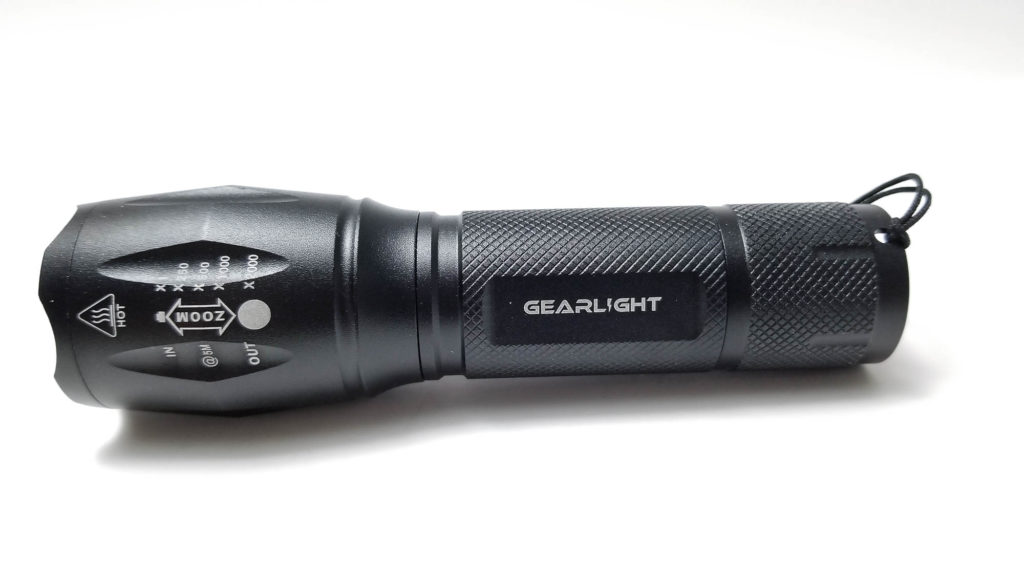
Gearlight S1000 specifications
| Brand/model | Gearlight S1000 |
|---|---|
| LED | Not specified |
| Max. Lumens | Not specified |
| Max. Beam intensity / distance | Not specified |
| Battery config. | 3*AAA / 1*18650 |
| Onboard charging | N/A |
| Modes | 5 |
| Blinkies | Strobe, SOS |
| Reflector | Aspheric lens |
| Waterproof | Not specified |
| Review date | April 2022 |
Introduction:
If you’ve been into flashlights for any amount of time, you probably have a good idea of what makes a flashlight a good one. However, the majority of folks who grab a flashlight probably wouldn’t know a good flashlight from a hole in the ground. The extent of their flashlight knowledge is probably gleaned from the biggest depository of consumer information (and misinformation) on the web: Amazon. A quick check for the most popular flashlights sold on Amazon returns zoomies with ridiculous specs and reviews are rife with terminology like “Crazy bright!” “Wide beam,” “Simply awesome,” “Great quality,” and my favorite, “Shines brighter than the sun.”
This is where the average consumer gets hooked into buying a flashlight with a counterfeit LED, blue tint, and terrible PWM. What’s a prospective buyer to do? Is this really one of the best flashlights on Amazon?
Well, 1Lumen is here to help.
Today I won’t be reviewing a professional-grade or enthusiast light. Instead, I’ll be taking a look at the most popular flashlight sold on Amazon, the Gearlight S1000. It’s advertised as a zoomable, “tactical” flashlight with high Lumens. I’ll put it through our standardized testing protocol and give it an honest, objective evaluation. Is it bright? Tactical? How about high Lumen? Is it even any good? How does it compare to a real budget light? I’m super curious to see how good (or terrible) the S1000 really is. Hey, if over 47,500 of the over 61,000 people who reviewed the S1000 gave it 5 stars, it can’t be all that bad, right?
Package quality.
The S1000 comes standard as a 2-pack. Yep, marketing folks know two-for-one deals work, so you’ll be getting not one, but two of the most-popular flashlights on Amazon. That said, the packaging is a simple cardboard box with a picture of (one) light on the front and loaded with colorful graphics and feature blurbs. Like most consumer-grade flashlights, you get a nice feature set:
- Two Gearlight S1000s
- Two lanyards (attached)
- Manual
- Warranty card
- Two AAA battery holders
- Two 18650 adapter sleeves/spacers
- Two holsters
The accessories are about what you expect at this price point, so they’re cheap, but not at all what I consider deficient. The Gearlight S1000 already includes more in the box than a Convoy S2+ and excludes batteries, this is everything you need to get started. That said, I am a little bothered by the fact there aren’t any batteries included since AAA batteries are cheap! Even $1 Ozark Trail WalMart flashlights come with batteries. The holsters seem serviceable but probably won’t hold up to much abuse, and the 18650 adapters are fairly-rigid plastic. The lanyards, while cheap, are adequate for a light like this.
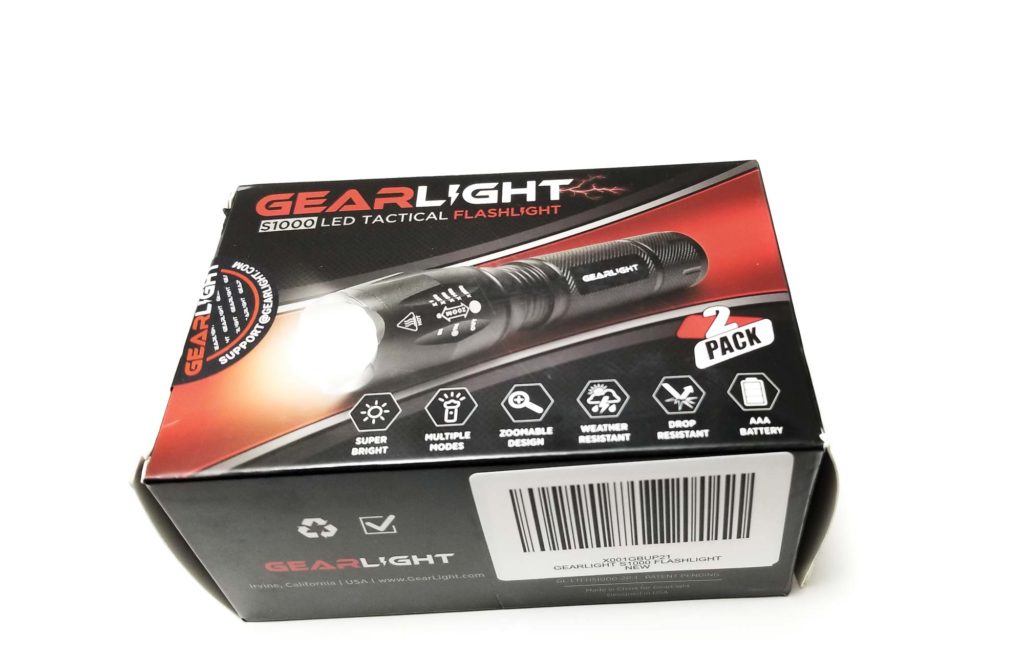
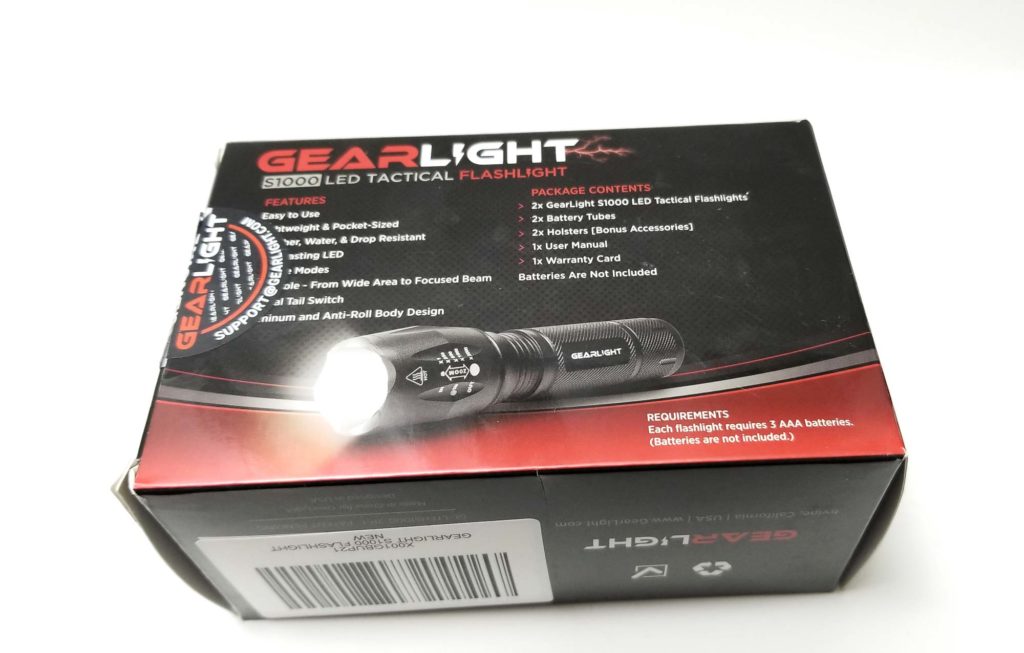
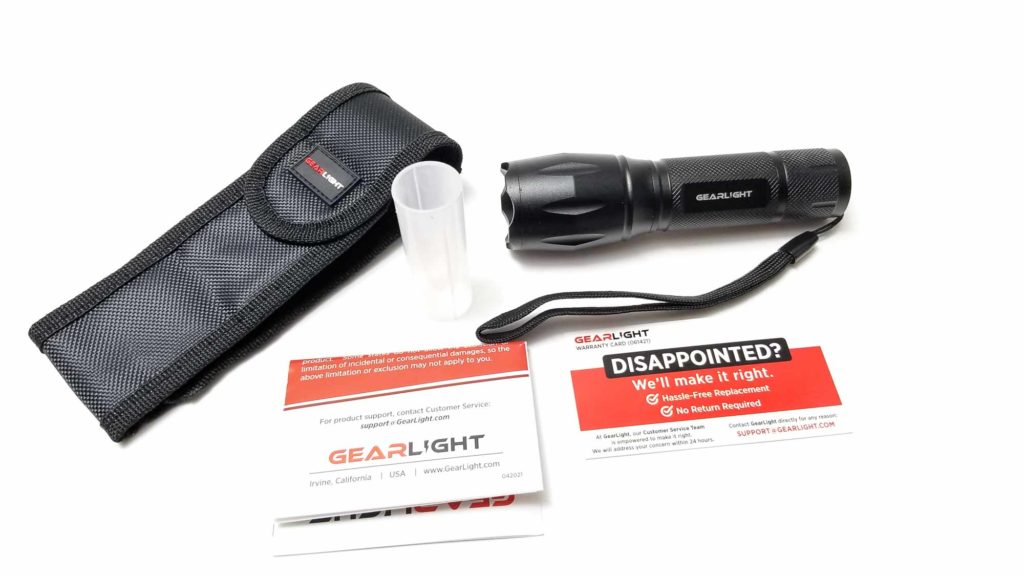
Flashlight in use
Now, let’s just get it out of the way: This is a zoomie. Uh oh, I said the z-word, which in some enthusiast circles elicits cringes, groans, or one-eyed Jack stares. Others might reach for their pitchforks, torches, and clubs, but folks, calm it down, and let’s put our prejudices aside for a moment because, to be honest, zoomies aren’t all bad. There, I said it.
The S1000 is a fairly-standard tube light that fits well in the hand, and even when loaded with 3 AAAs or an 18650 it’s surprisingly lightweight with good balance. The tube is a bit chubby for what amounts to an 18650-size light, but this is good for maintaining a good purchase on the light, and it’s short enough that most hand sizes can reach the rear switch easily.
The rear switch is a reverse clicky, so it must be fully depressed and released before the light turns on. Once on, mode changes are facilitated by half-presses. The click action feels okay and while a bit mushy, it’s serviceable. The boot is a bit thin and I could easily feel the switch underneath. There are two types of zoomies: Push-pull or telescopic, and twisties. The S1000 is a push-pull zoomie, so the entire head slides forward and backwards to adjust the beam from spot to flood. The travel is about 2 inches, so there’s lots of adjustability to have as much or as little flood as you want, or all-out bat signal. The zoom action is pretty smooth with only a little bit of notchiness.
The head has scallops milled out to help with grip (and adds anti-roll).
The tailcap and body have traditional (albeit pretty shallow) knurling for grip, and there’s a single lanyard hole in the tailcap, but no place to mount a pocket clip. I don’t think one is really needed, since the light fits in my pockets easily. Tail standing is easy-peasy and stable since the switch doesn’t protrude. The scalloped cuts in the head keep it planted on an inclined surface, something some expensive lights don’t have. Overall, the S1000 is pretty maneuverable and handles about like my Acebeam L17, although that light is much heavier.
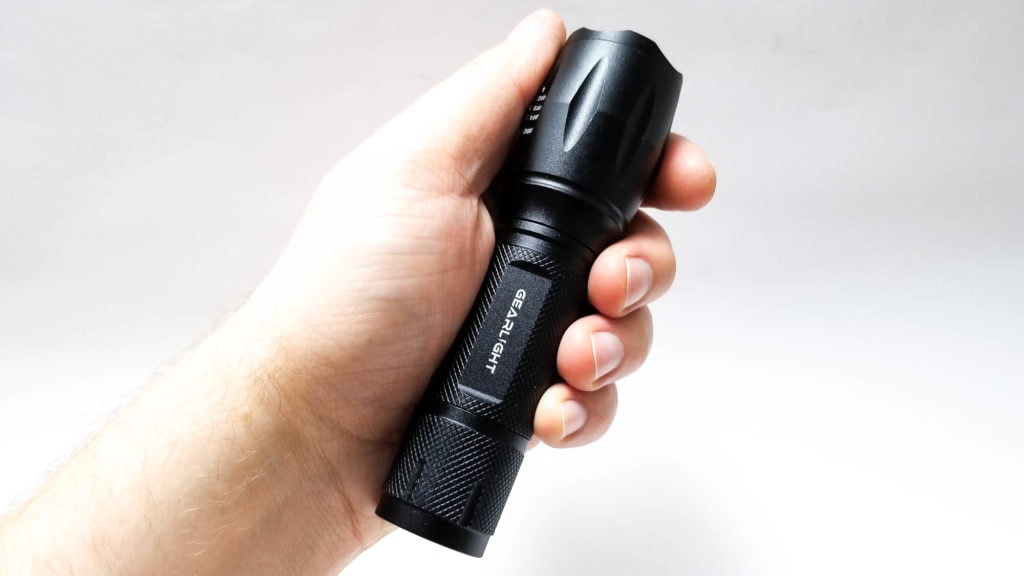
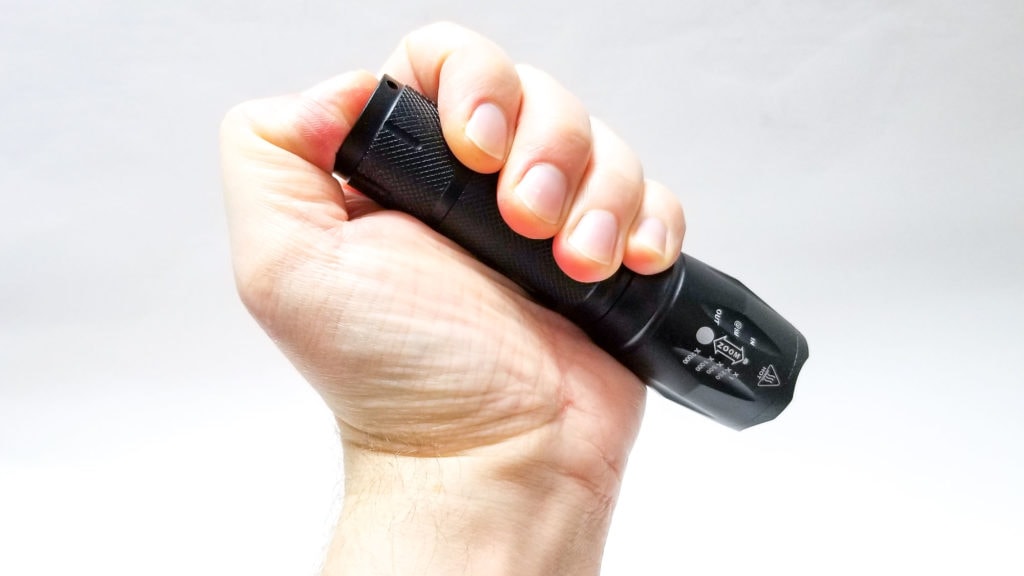
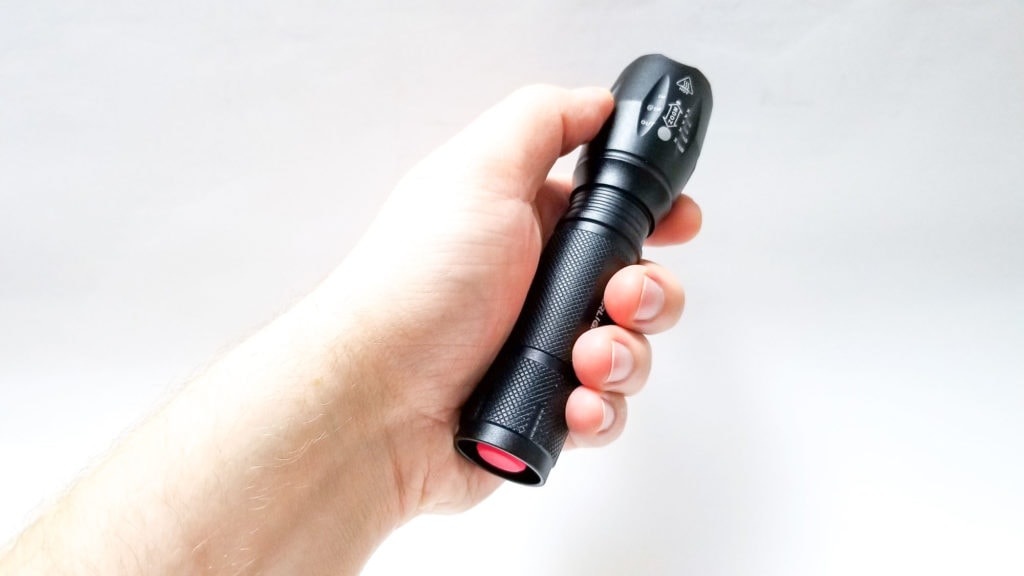
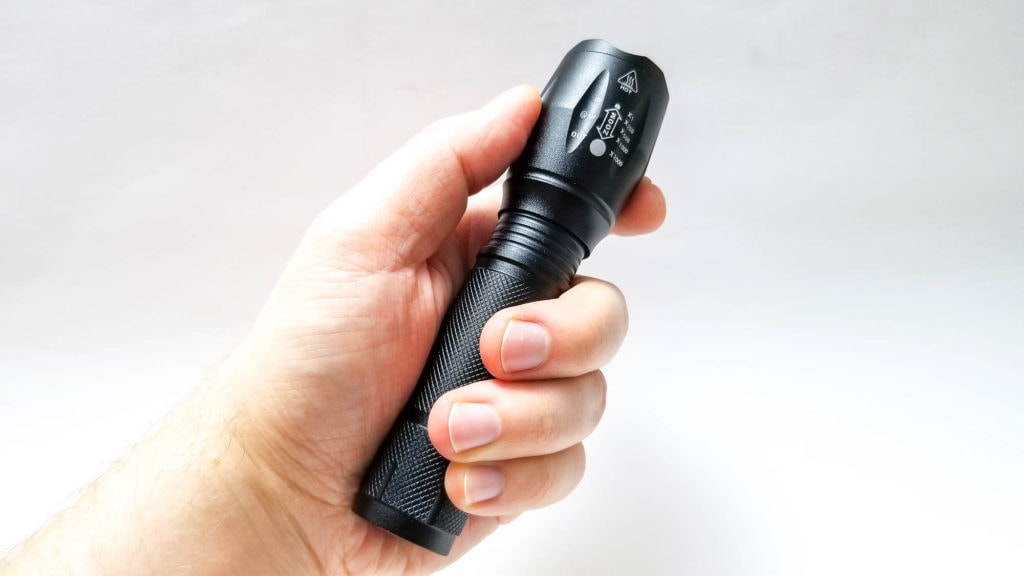
Build Quality, and Warranty
Here’s where we start getting into the areas where quality consumer-grade and enthusiast lights distance themselves from lights like the S1000. Since the S1000 came as a two-pack from Amazon for about $21 US (without shipping), about $10 for a single light is a pretty good deal. On the flip-side, a nice budget flashlight like a Sofirn SP10 V3, Skilhunt E2A, or Lumintop Tool AA 2.0, runs about $20-$25 (sometimes less with sales). The Convoy S2+ runs about $15 to $20. Those are far superior flashlights, but remember, you’re getting two S1000s, remember?
Although it’s cheap, the S1000 isn’t terrible. I’d say it’s adequate. The light is constructed from “virtually indestructible military-grade aluminum” (from the listing). I doubt it’s military-grade or indestructible, but hey, it’s better than plastic.
Build quality? Aside from some slightly abrupt edges on the bezel, the rest of the edges are smooth, which is something even some higher end lights are missing. Looking inside the (plastic) lens, the retaining ring holding the LED down is made of aluminum, but it’s not finished particularly well and has visible flashing on the inner part. The finish seems like real anodizing instead of paint, and it’s a decent matte finish. I didn’t see any major issues with coverage or defects, so that’s nice. The silk screen graphics are sharp and precise as well. So far, the finish has held up okay, but in the short time it’s ridden in my pockets with my keys and other flashlights, the finish is wearing through in spots. It is not as durable as a true MIL-STD type III HA.
The removable cell carrier is made from thin plastic and contains springs and solid contacts for the connections. There’s a thin steel spring with a gold-like plating on the driver side, and the tail has a spring-loaded “plunger” contact mounted in a plastic retainer I see on other cheap lights. The battery carrier has small gold-plated springs for the negative contacts and bumps for the positive contacts. There’s brass-plated steel strips for the series connections, and the positive end that contacts the driver spring has a spring-loaded plunger like the tailspring. This is probably to take up the space needed for the 18650s extra length. It’s definitely not a low-resistance current path, but it doesn’t need one.
Interestingly, the light can almost be completely disassembled. The bezel unscrews to release the aspheric lens, and the anodized aluminum retainer that holds the MCPCB down can be unscrewed exposing the LED mounted on a 20 mm aluminum MCPCB, so you could feasibly swap the LED out. I tried unscrewing the pill, but it’s either integrated into the battery tube or glued on as I couldn’t get it off without potentially damaging it. The rear threads are fine triangular cut, seemed fragile, and very short, maybe 6 mm long. I had to be careful not to cross-thread them.
Lube? Nope, and they weren’t the smoothest, but they worked. Surprisingly, there are o-rings sealing every mating surface. The bezel has one, as does the lens, and the tailcap. Very impressive! There are o-rings sealing (and providing resistance) to the zoom head as well. There’s no claimed IP rating other than “built to defy the weather.” I’m not aware of an IP rating for that, but I’d imagine it’s somewhat water resistant.
The warranty is handled by whoever sold you the light, so you’re at their mercy. Thankfully, since these are sold exclusively through Amazon, you are afforded excellent return/exchange policy. There is a warranty card in the box as well, with a support line and a guarantee on functionality with the assurance that If it breaks or malfunctions, send it back for a refund or replacement.
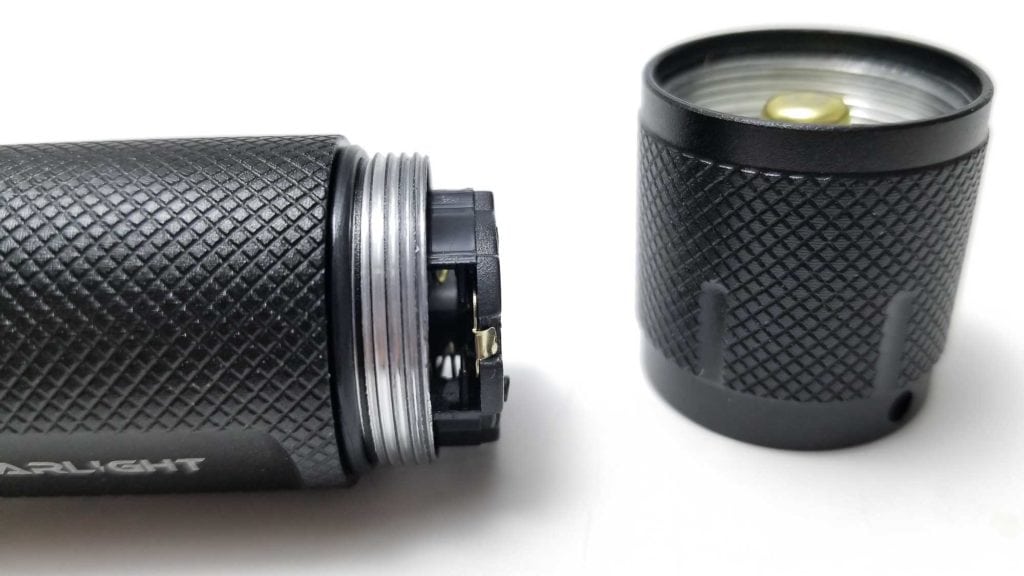
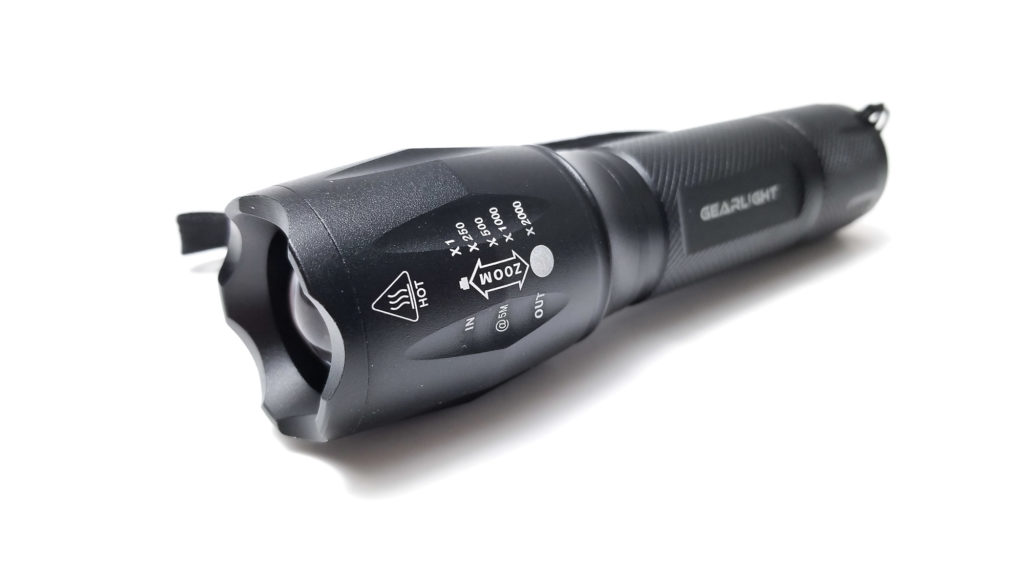
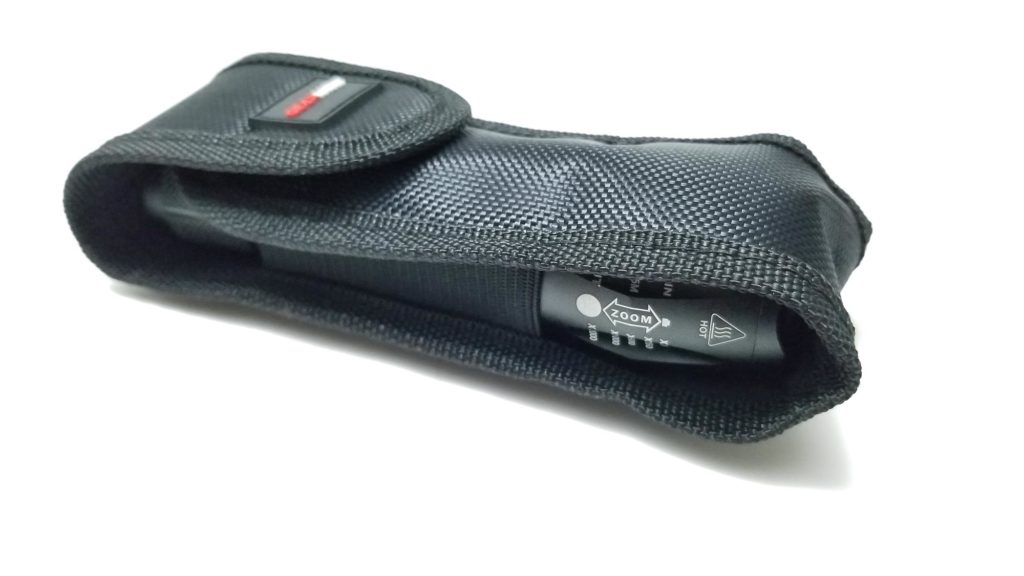
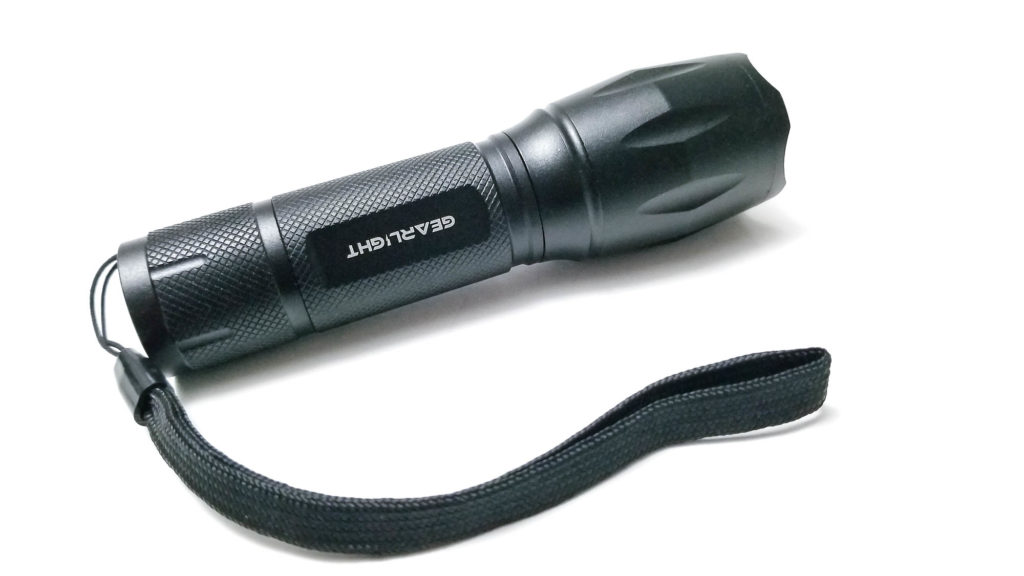
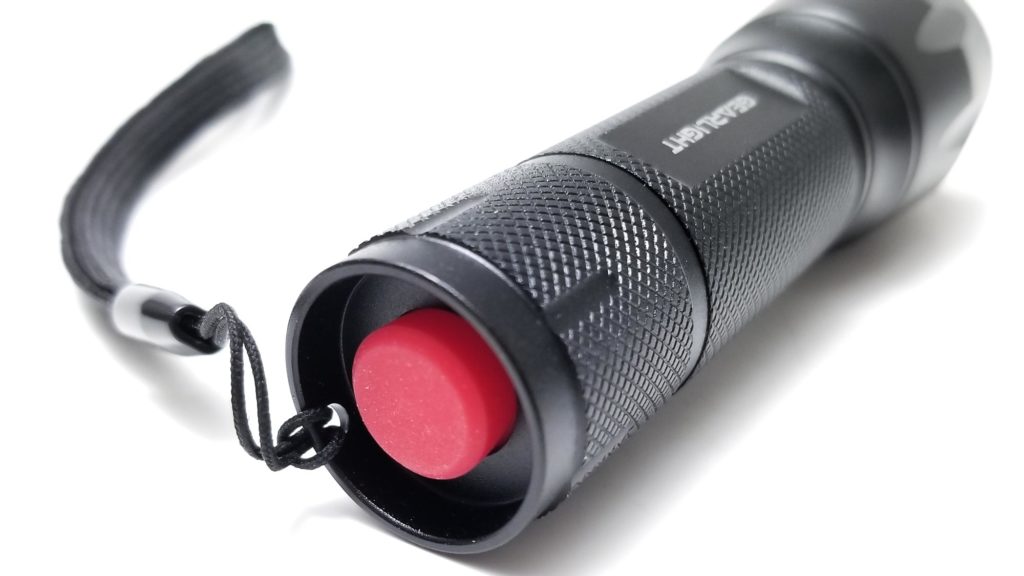
LED, Lens, Bezel, Beam, and Reflector
While even the lowest-cost, but still good quality budget lights still have name brand LEDs, no so with the S1000 because it’s sporting arguably the most-copied LEDs on the market today, a fake Cree XM-L style LED, and this is probably one of the dozen or so counterfeits available on the Chinese market. No tint is specified, but it sure looks very cool and more blue than white. I ran it through the Opple Lightmaster Pro on the High setting.
Since the S1000 is a zoomie, the light from the LED is focused by an aspheric lens mounted to the head. The LED stays in a fixed position, and the lens extends and retracts. The aspheric lens is pretty small, made from plastic of some kind, and it was somewhat defect-free out of the box. There’s no lens protecting it and the lightly crenulated bezel doesn’t offer much protection so it will get scratched up.
Okay, the beam. Since this is an aspheric zoomie, the shape of the beam changes based on the distance the lens is from the LED. When fully zoomed out, the LED is closest to the lens and the beam is very wide. When the head is fully extended in the spot position, the LED is farthest away from the lens. When zoomed out, it’s a circular floody beam with a sharp cutoff on the periphery with no diffuse spill or hotspot, and when zoomed in, you get an image of the LED light emitting surface, save for the part where the bond wires connect to the die, which creates the familiar ‘bat signal’ phenomena.
There’s no spill, so it’s kind of weird-looking if you aren’t used to it. This is less-than desirable for uniformity and an overall pleasing, symmetrical beam pattern, but that said, I don’t mind it. When properly done, a zoomie beam can be very versatile.
What about tint and CRI? Well these are kind of a misnomer at this price point, and the fake XM-L doesn’t disappoint. The Opple Lightmaster Pro recorded the tint around 8800 to 8900K with a (surprising/shocking) CRI at 88. The duv? -0.0023, it’s a bit below the BBL. At least it’s not angry blue.
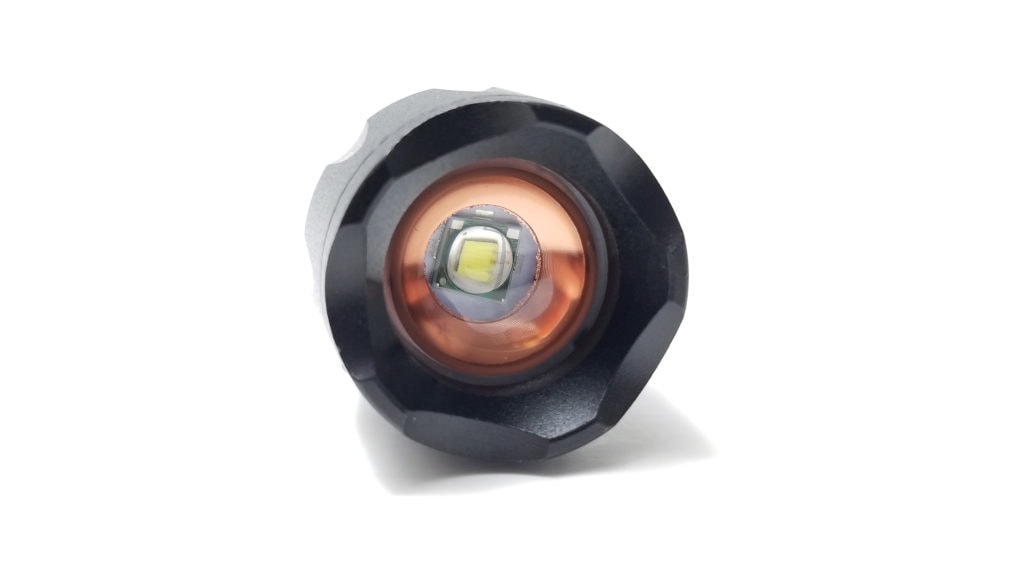
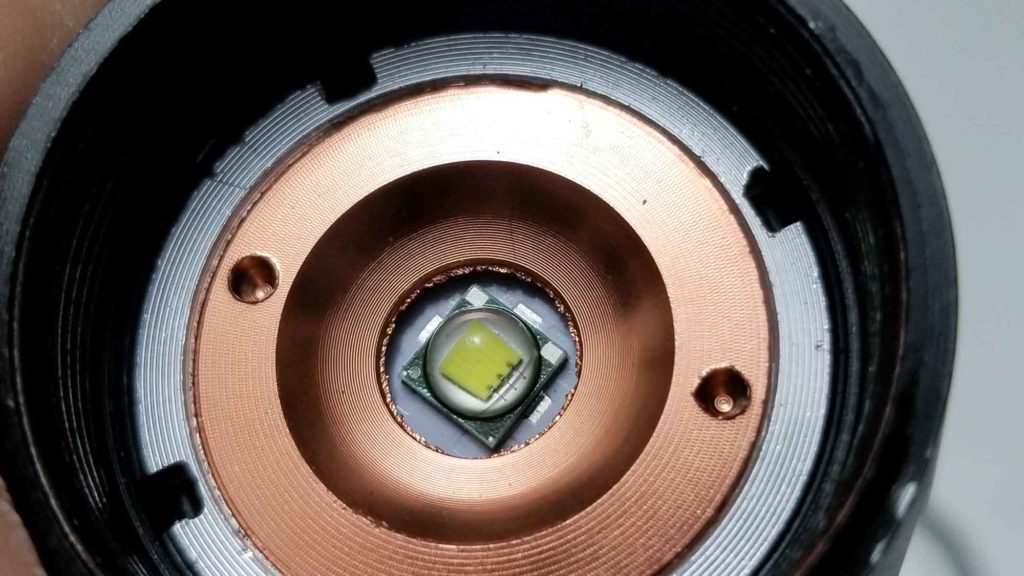
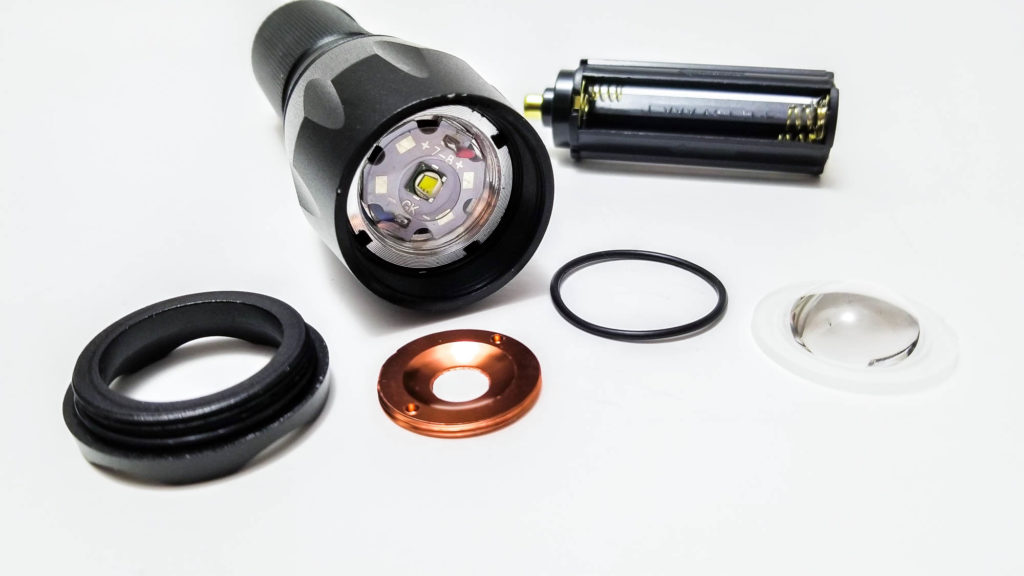
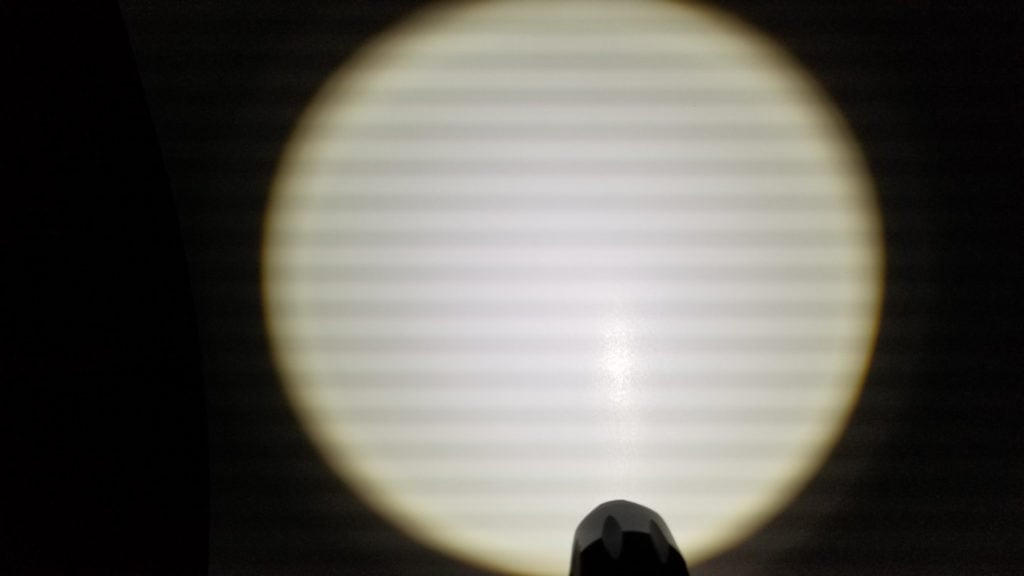
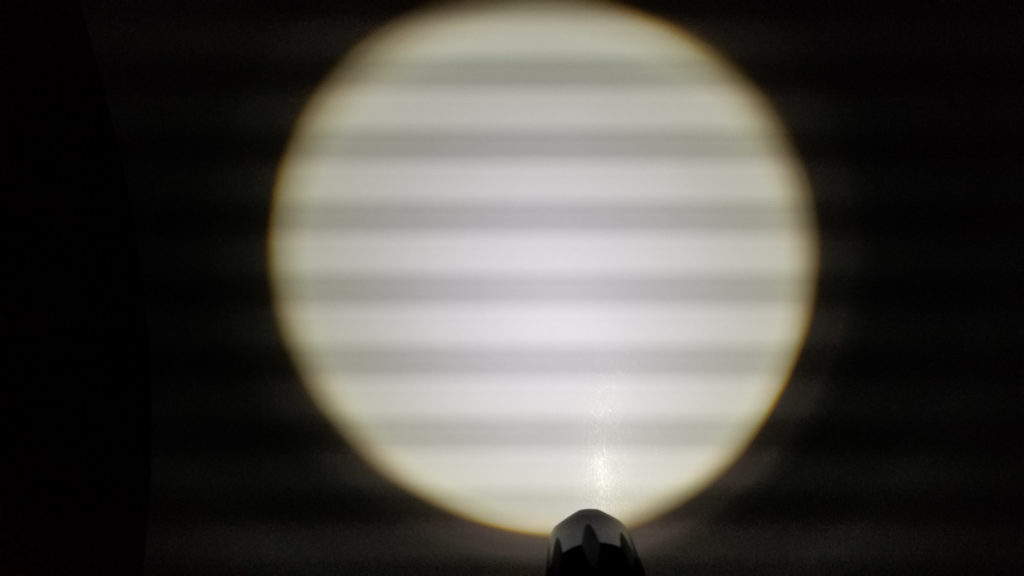
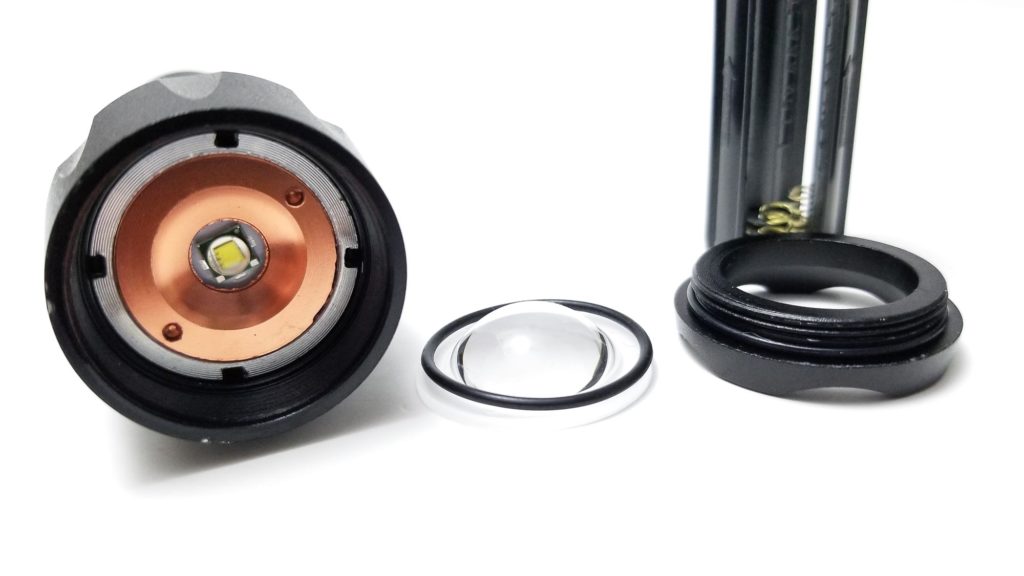
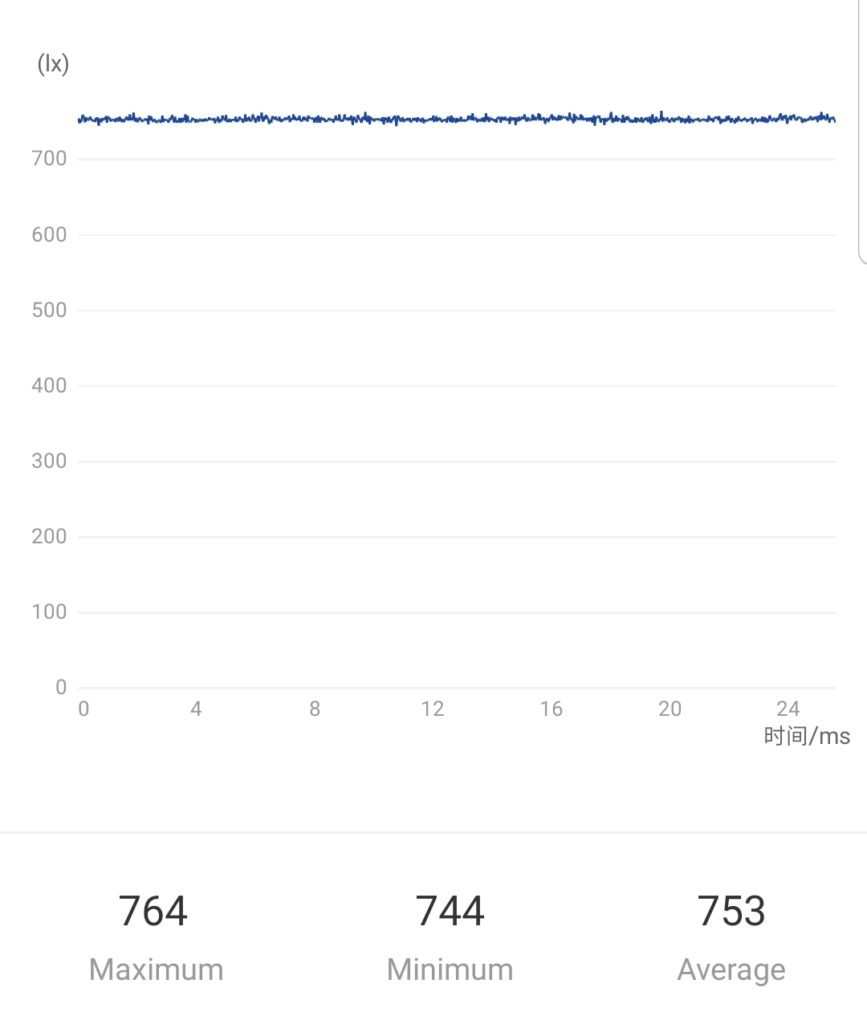

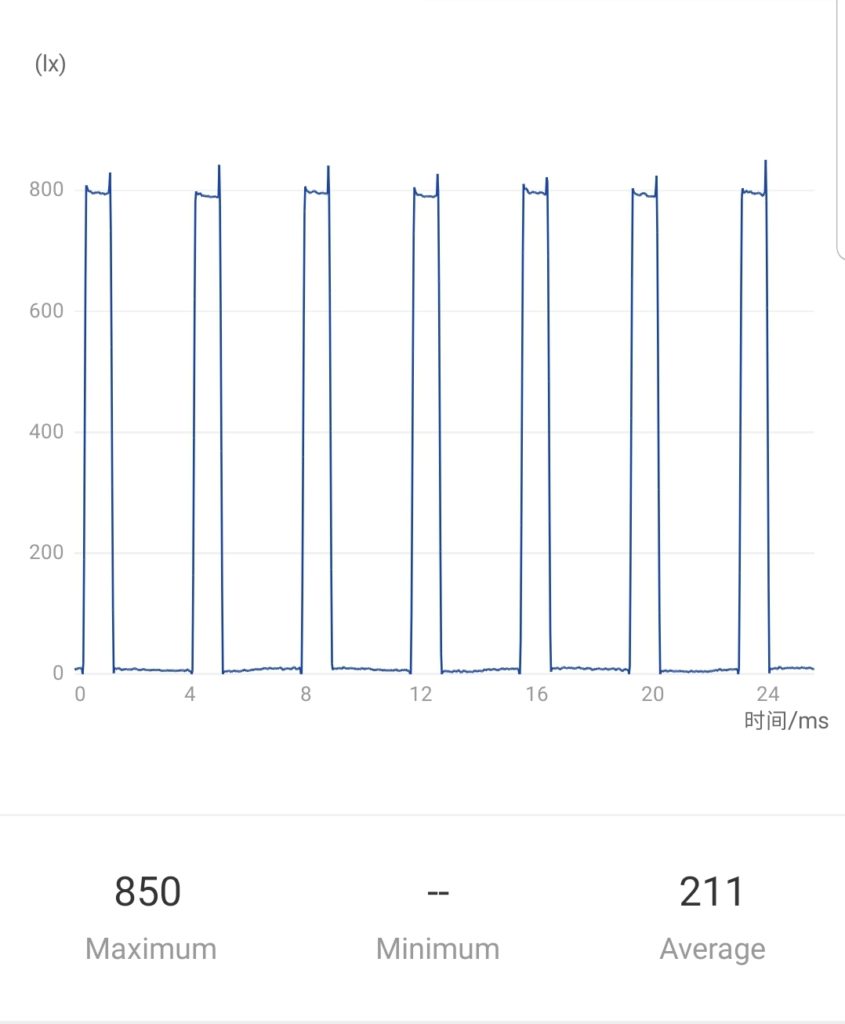
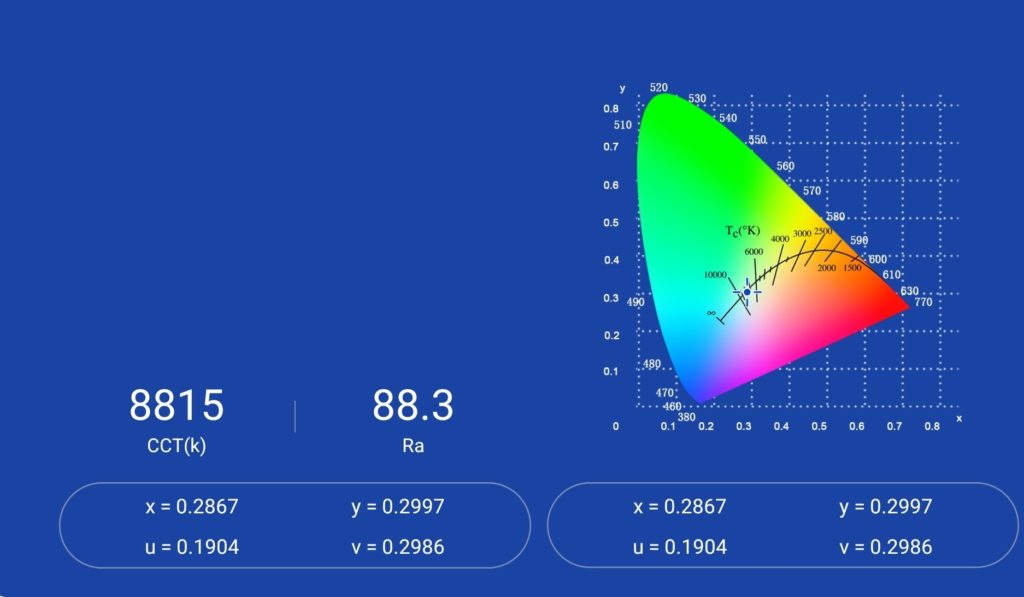
Dimensions and size comparison
Length:
- Length (head retracted): 13 cm / 5.11 inches
- Length (head extended): 14.2 cm / 5.59 inches
- Body: 2.8 cm / 1.10 inches
- Head diameter (at widest point): 3.7 cm / 1.45 inches
Weight:
- Without cells+battery carrier: 121.9 grams / 4.29 oz
- With 3x AAA Alkaline batteries: 156 grams / 5.49 oz
- With LG 2750 mAh 18650: 168.3 grams / 5.93 oz
Flashlight comparison
I compared the S1000 to some similar zooming and non zooming flashlights. I threw in the first serious LED flashlight I ever owned, a Nebo Redline twistie zoomie from 2010. Since Gearlight says the S1000 is a tactical flashlight, I included some real tactical-use lights.
Group 1 left to right: UniqueFire UF-20 twist zoomie, cheap telescoping zoomie, Gearlight S1000, Quantum 520-Lumen zoomie, Nebo Redline twist zoomie
Group 2 left to right: UF-T20, Gearlight S1000, Quantum (Harbor Freight Tools store brand) zoomie, and Nebo with zoom heads fully extended
Group 3 left to right, with more transitional flashlights: Astrolux EA01, Gearlight S1000, Thorfire C8, Sofirn SP10 V3, Wuben F1.
Group 4 left to right 18650-size tactical flashlights: Fenix PD35 V3, Speras E3, Gearlight S1000, Klarus XT11GT Pro V2, Acebeam L17, Acebeam P15 Defender.
Group 5 left to right (for fun) dirt-cheap flashlights. Besides the S1000, all are $1 or less: Gearlight S1000, Ozark Trail OL-50 (from WalMart), Convoy S2+ clone, 3xAAA DollarTree light, another 3xAAA DollarTree light (with worklight!)
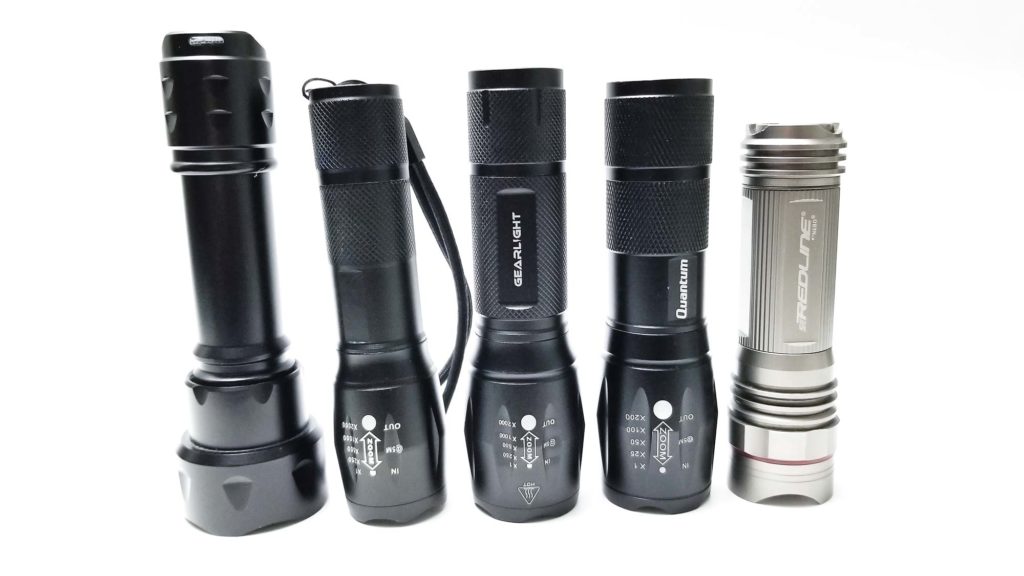
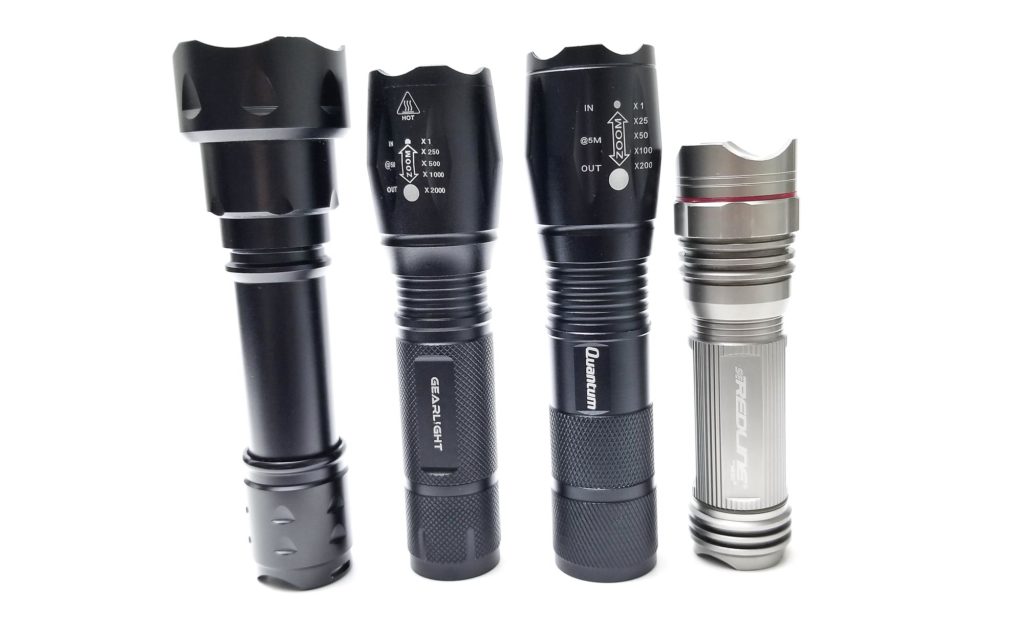
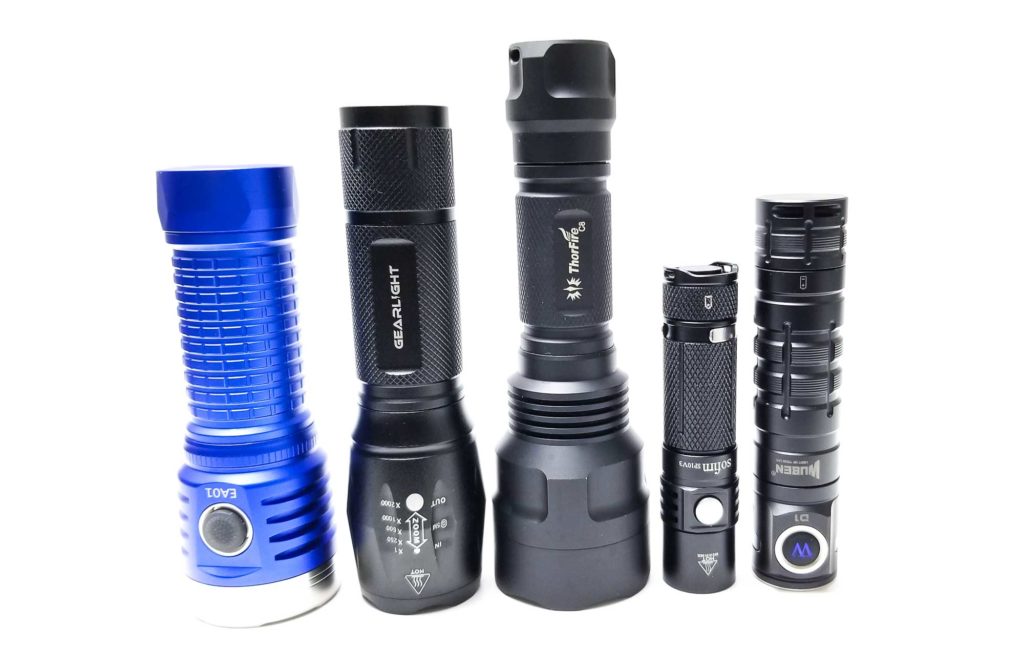
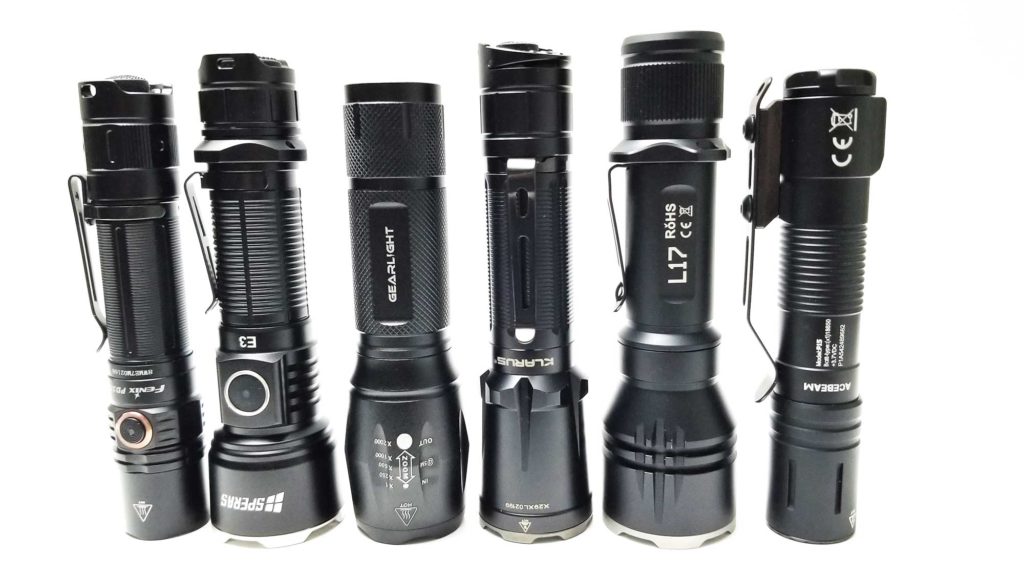
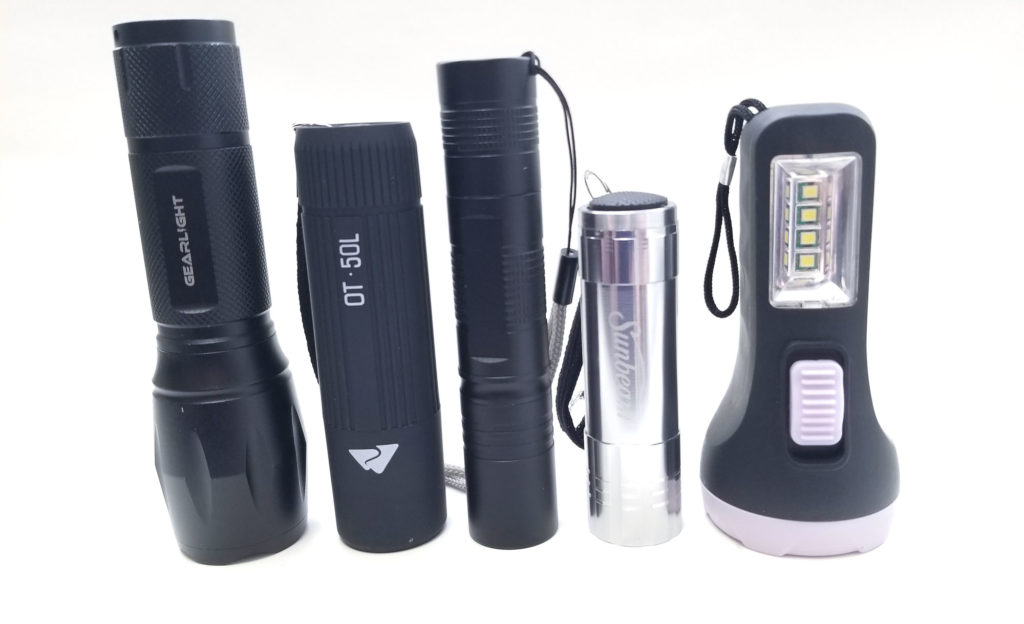
Driver & User Interface:
I can’t comment on the driver, but it’s most likely a very simple resistor bank and or a transistor with a simple MCU for the modes. Brightness is most certainly controlled by PWM, with the high mode being direct drive. These cheaper flashlights make do with the cheapest of drivers and that means as the batteries drain, the light output decreases proportionally.
The UI is exceedingly simple. It’s 5 modes, with a Low, Medium, and High mode plus two blinkies: Strobe and S.O.S. Mode memory? Nope. Ramping? Nope. Mode sets? Nada. Fully click the switch to turn on, half-press to change modes, click to turn off. Told you it was easy.
Available modes: Low, Medium, High, Strobe, S.O.S.
From OFF:
- Single click: Turns on
- Half-press: N/A
- Double click: N/A
From ON:
- Single click: Turns off
- Half-press: Switches modes
- Double click: N/A
Mode memory:
- Nope. Always turns on in High.
Shortcuts:
- Nope
Low voltage warning:
- Nope, but there is LVP (low voltage protection)
Strobe/blinkies
- Strobe and S.O.S.
Lock-out mode:
- None. Not even mechanical.
PWM
- Yes. It’s easily visible with the naked eye in Low and Medium modes. I can’t quantify Hz figures, but using the Opple Lightmaster Pro’s “flicker” function, it gives an idea of the severity of the PWM duty-cycle in Low and Medium modes. I didn’t notice PWM in High mode, and that makes sense because it’s direct drive.
Additional info on the UI:
- There’s not much to say about the S1000 UI. It’s typical of cheap flashlights with bad PWM on Medium and Low modes and zero creature comforts like mode memory, visual LVP, or lockout. There’s no thermal management or timed stepdowns either. However, it is very simple to use with no user-set modes or configuration or calibrating necessary. Basically, there’s no way a novice user could mess up the S1000 UI like with Anduril/Anduril2. The mode spacing is decent, and to be fair, it doesn’t need temperature control. I would like to see a lower-Low mode though (although the PWM makes it unbelievably annoying), and I don’t like how it turns on in High (good for tactical use lights…not this one). The blinkies are part of the regular mode set, so to get to Medium, you have to cycle through Low, Strobe, SOS, and High. Annoying. Since it always turns on in High mode, don’t grab the S1000 in the middle of the night or you’ll get a nice surprise when you click it on! Mercifully, there is LVP, but it’s invisible, meaning the light keeps dimming until it shuts off!
Batteries & Charging
There’s a few battery options for the S1000. By default, it’s a 3 AAA light, and can use either Alkaline, carbon-zinc, Nimh, or Nicad rechargeables. The AAAs are housed in a familiar carrier which arranges them in series for 4.5 volts total (actually a bit higher with fresh Alkaline batteries at 4.84 volts and 4.19 with Nimh). I’m glad the batteries are easy to load and remove without resorting to a tool of some kind, and they seem to be held in securely.
If AAAs aren’t your thing, you can use an 18650 li-ion cell thanks to the included adapter. The adapter is just a plastic sleeve that fits around the 18650 to increase its diameter, and I highly recommend this to get the most out of the light. A single, low-capacity 18650 has many, many times more watt-hours of energy than even 3 high-capacity Nimh or Alkaline AAA batteries. Plus, you can store a li-ion battery in the light for long periods, unlike Alkaline batteries, which can leak over time and destroy the light (ask me how I know that!).
There’s no onboard charging, which is fine for Alkalines. When they go flat, you can responsibly dispose of them, but if you use Nimh or 18650, you’ll need a separate charger. I tried an Acebeam 3100 mAh 18650 with built-in charging, but it fit, but it’s a tight squeeze that compresses the tail and driver springs quite a bit. If you don’t have an 18650 with built-in charging, there’s universal chargers that charge Nimh and li-ions for about $15.
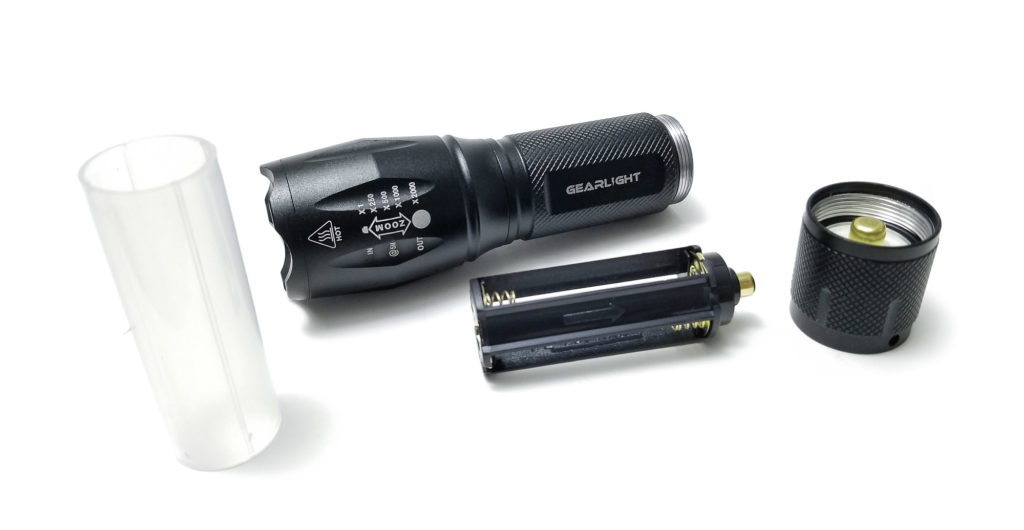
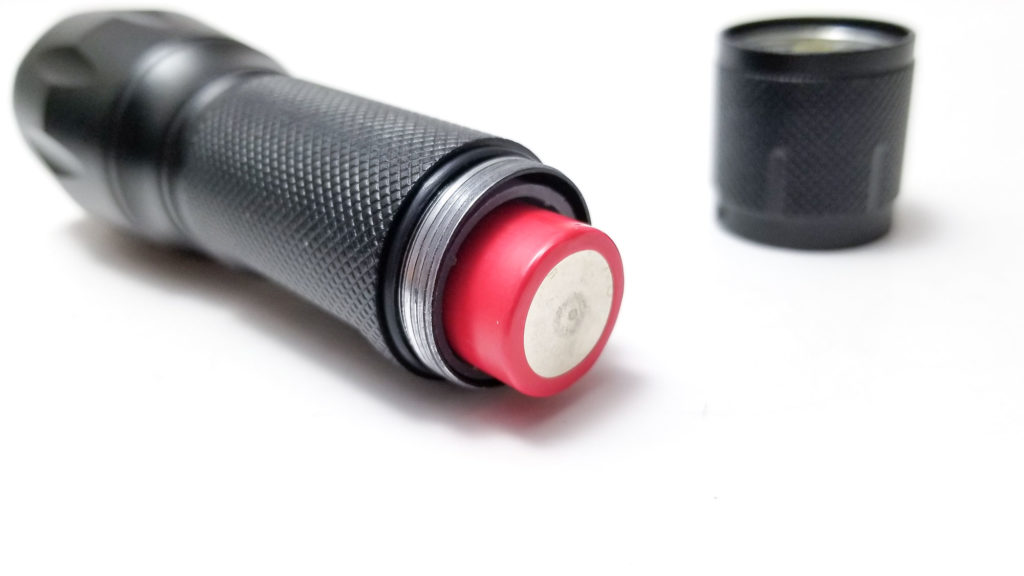
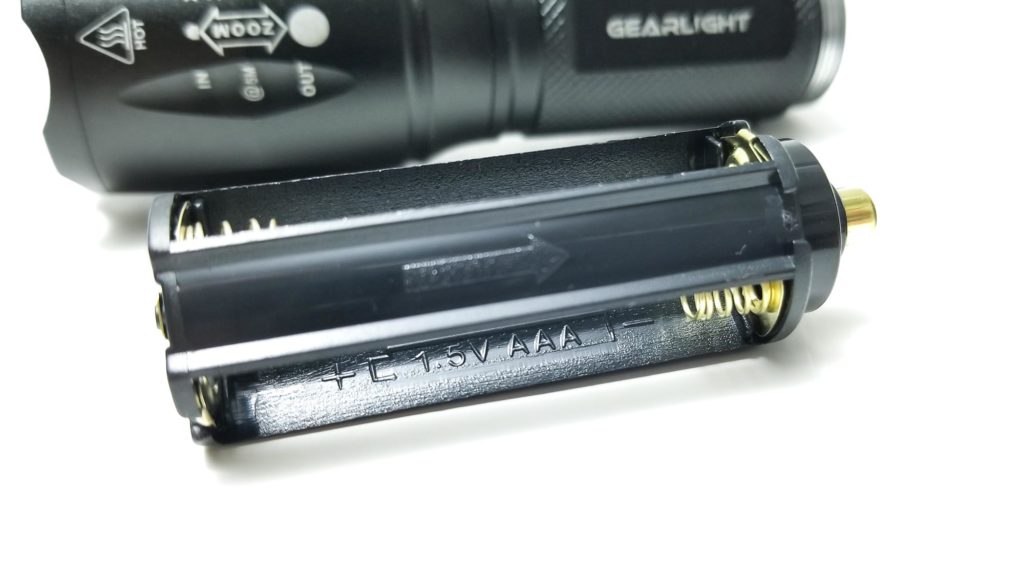
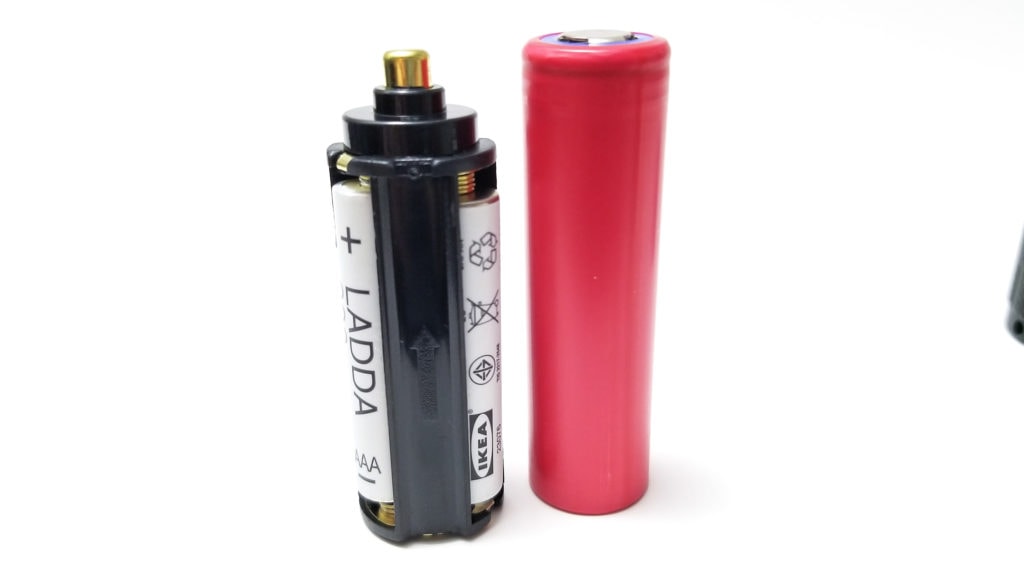
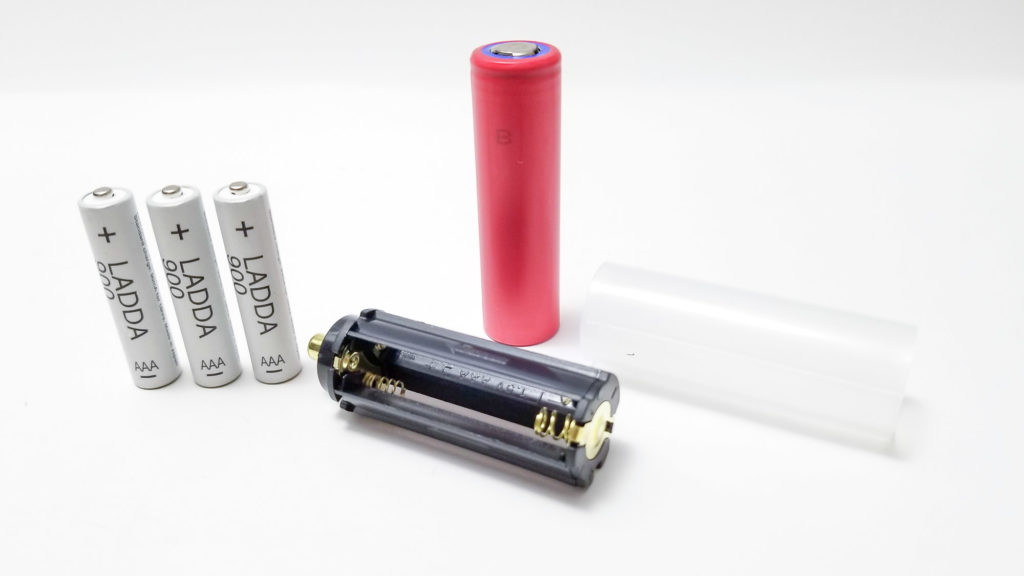
Performance test
Lumen measurements:
I’m actually looking forward to this bit since this is one area where cheap flashlight manufacturers grossly over exaggerate specs, and one reason why 1Lumens exists! Expensive flashlights from reputable manufacturers are usually pretty trustworthy with their performance specs, but with these cheap ones, their specs are about as trustworthy as a fox in a hen house. We see figures like 90,000 Lumens and 1 km of throw routinely advertised with similar cheap-o lights, and although you can get a flashlight that will throw 1 km and one that makes 90,000 Lumens, spoiler alert: This one doesn’t.
I am affording the S1000 no special treatment here, and it will undergo the same battery of tests that a more expensive flashlight would. I test output, runtime, and candela/throw. Lumens are measured in my 30 cm integrating sphere that’s been calibrated with several lights of known output including a Makkua-calibrated Convoy S2+. I use a Digi-Sense 20250-00 data logging lux meter for measurements. Zoomies lose a lot of light in the spot position (head fully extended), I ran these tests in the flood position (head fully retracted).
Since the S1000 can use Alkaline, Nimh, and an 18650, the test was conducted using a fresh set of AAA Alkaline batteries, fully charged IKEA Ladda 750 mAh Nimh AAA, and a fully charged LG ICR 2750 mAh 18650 cell. This is a low drain (low current-handling) battery, and it will be interesting to see how it affects the output.
| Mode | Amps at start | Specs | turn on | 30 sec | 10 min |
|---|---|---|---|---|---|
| Low | Alkaline: 348 mA | ? | 58 lm | 58 lm | – |
| Nimh: 333 mA | ? | 60 lm | 60 lm | – | |
| Li-ion: 480 mA | ? | 75 lm | 75 lm | – | |
| Medium | Alkaline 681 mA | ? | 119 lm | 108 lm | – |
| Nimh: 642 mA | ? | 123 lm | 123 lm | – | |
| Li-ion: 990 mA | ? | 143 lm | 141 lm | – | |
| High | Alkaline: 1.48 A | ? | 227 lm | 194 lm | 147 lm |
| Nimh: 1.36 A | ? | 226 lm | 198 lm | 185 lm | |
| Li-ion: 2.13 A | ? | 289 lm | 245 lm | 213 lm |
To give an idea of just how much light is lost in the spot position when the head is fully extended,I tested Low, Medium, and High using the Nimh batteries (at turn on):
| Mode | Output: zoomed-in (tightest beam) |
|---|---|
| Low | 22 (was 60 with the widest beam) |
| Med | 44 (was 123 with the widest beam) |
| High | 86 lm (was 226 with the widest beam) |
From flood to spot, High mode is down about 140 Lumens. In a more powerful light that’s not a big deal, but here it’s huge. What gives? This is because of the design of the zoom head and aspheric lens. As the lens is extended away from the light source, the light is being blocked (like shining a light through a toilet paper roll) and the lens is only capturing a small portion of the actual light being produced by the LED. Since LEDs typically throw light in a 115 to 120 degree angle, the lens is only capturing a small portion of it when the head is fully extended and the rest is wasted.
Parasitic drain:
- None, it’s a clicky switch.
Runtime graph
I tested the runtime in my 30 cm integrating sphere calibrated using several lights if known output including a Makkua S2+ with the Digi-Sense 20250-00 data logging luxmeter with a fresh set of Alkaline AAAs, IKEA Ladda 750 mAh Nimh, and an LG ICR 2750 mAh 18650. I only tested High mode with the head in the flood position since it produces the most usable light.
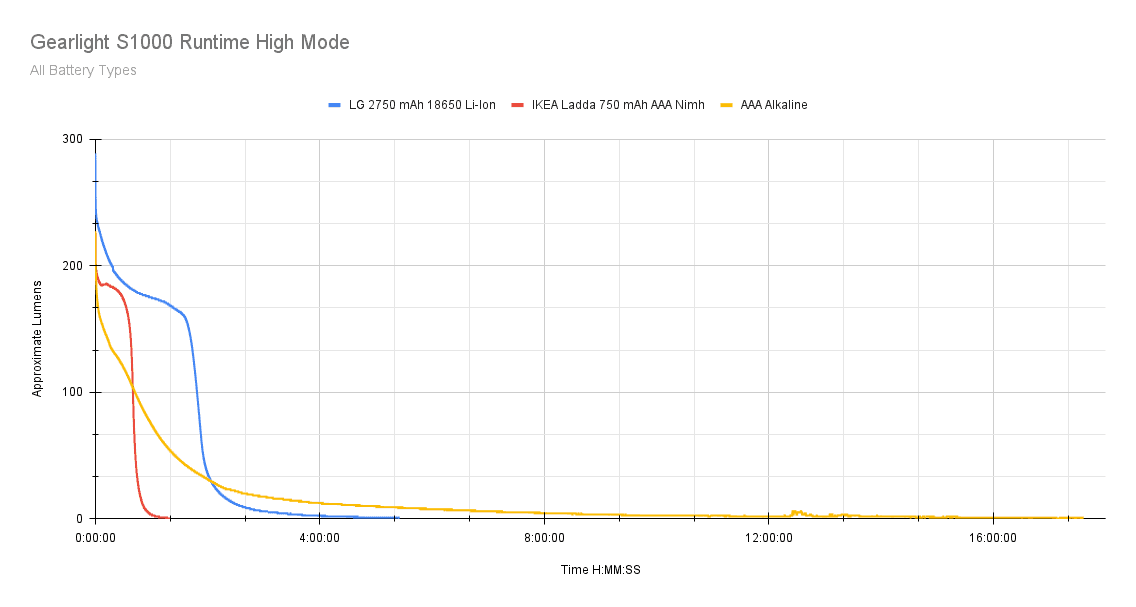
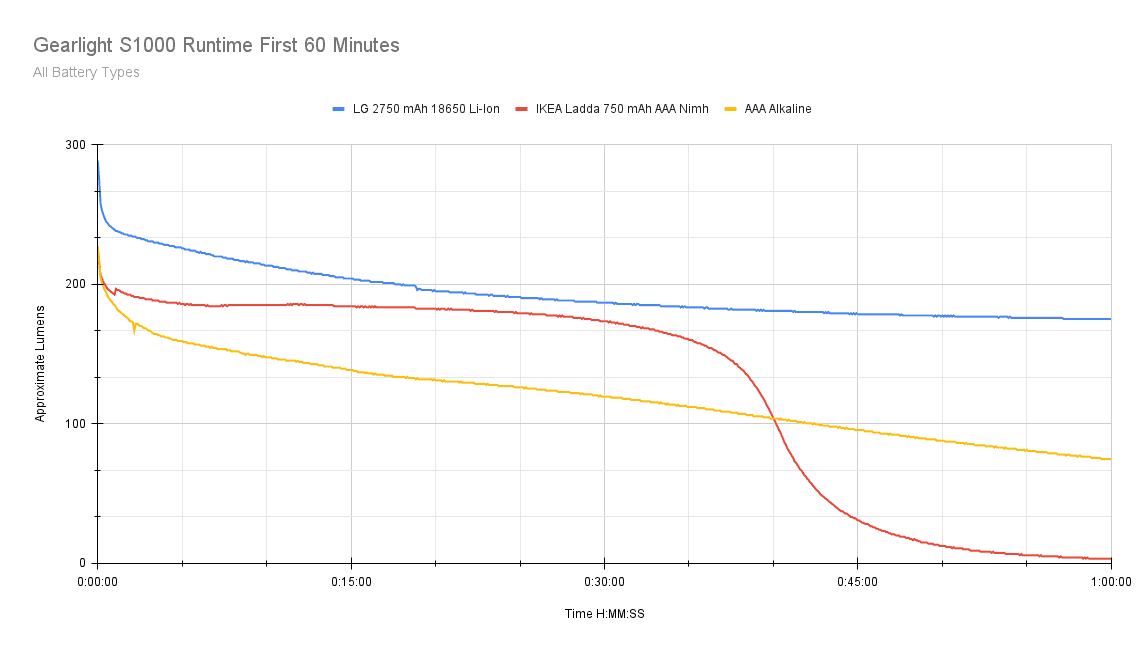
For the 18650, the test started at 288 Lumens, and not surprisingly, the output dropped fairly quickly, but not drastically. By 5 minutes in, the output is only about 53 Lumens off from start, and by 30 minutes, it’s only down about 100 Lumens, which isn’t bad at all. Even at the 60 minute mark, it’s still 100 Lumens brighter than the Alkaline batteries. What was surprising was the heat because this thing got pretty toasty, but it heated up slowly. By 60 seconds, from 21.5 ambient, the head is at 29 C. Now, keep in mind the heat is localized to the body under the head because the head isn’t physically attached to it (it’s riding on a couple o-rings to provide friction for the movable head) so the body probably got warmer. By 30 minutes, it’s up to over 50 C, but that’s as hot as it got. Even so, it’s still hand-holdable. There is LVP with this light, and after a long, slow decline in brightness over the next 4 hours, the light shuts off at the 5 hour 24 minute mark. The cell was right at 2.48 volts, a bit low, but better than the light continuing to run until the cell gets down to 1 volt.
On the IKEA Ladda 750 mAh Nimh batteries, the output is down from the li-ion, but not by much. Starting at 225 Lumens, the output slowly declined in the same fashion as the li-ion battery, holding about 200 Lumens for the first 3 minutes. The output didn’t take a sharp drop until the 40 minute mark, when it dropped below 100 Lumens, and from there it was all downhill. By the 1 hour 10 minute mark, the output is very low, under 1 Lumen, and it kept running like that for a very long time. I actually ended the test at 1 hour 18 minutes since I knew it would keep running nearly indefinitely. Unlike the li-ion battery, the light didn’t heat up much. At 3 minutes the head was only 30 C, a 7 C increase from ambient, and it didn’t get any hotter. The battery carrier voltage was right at 2.63 volts when I ended the test.
The Alkalines started about the same as the Nimh batteries, and the discharge curve was very similar. The only difference was they lasted a lot longer than the Nimh. The Alkalines are still about 50 Lumens when the Laddas kicked the bucket, and kept going for the next…16 hours. I ended the test at 17 hours 35 minutes because the output dropped very low and stayed there (reminiscent of an Anduril light) for an eternity. The light was pretty much unusable for daylight use by the 1 hour 30 minute mark anyway. The carrier was at 2.7 volts when I ended the test. Alkalines are great for backup, not as your main power source.
What’d we learn here? This is typical of an unregulated, direct drive flashlight driver. As the batteries drain, the light dims until either LVP shuts everything down, or it gets so dim that you replace the batteries. There’s no thermal regulation either, and I think it would have been a good idea when using a li-ion cell, but otherwise it’d be pretty useless, and probably make the driver more expensive. Larger capacity will give you longer runtimes, and higher voltage will give more output. It was nice to see LVP, but 2.48 volts is a bit low to discharge a li-on battery.
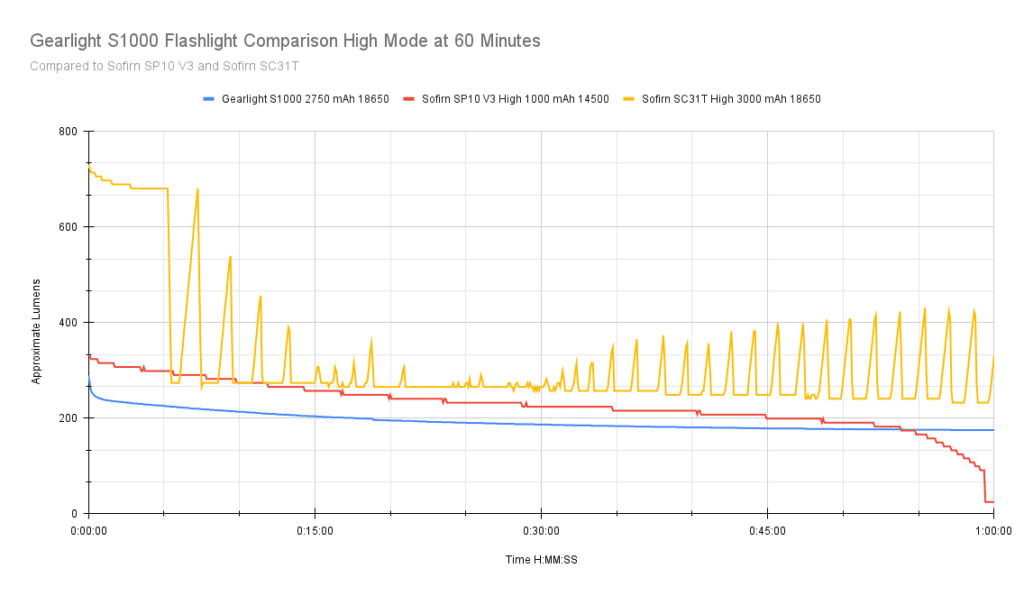
For yucks, I threw in the High mode runtime graphs of two competing flashlights, the Sofirn SP10 V3 and Sofirn SC31T. The SP10 V3 can use AA li-ion batteries, and the SC31T is 18650 only, I compared those to the S1000 runtime on the LG 18650. We can see marked improvements in both output and sustainability with the two Sofirn lights. Obviously, the SC31T is far brighter, and has thermal regulation, but notwithstanding, this is superior performance for only about $12 more for the SC31T, and $4-$5 more for the SP10 V3 (both lights include a li-ion battery with purchase).
Throw numbers:
I measured the throw with the Uni-T UT383S luxmeter indoors at 5 meters. I took readings with the IKEA Ladda Nimh, fresh Alkaline AAA, and the LG 2750 mAh 18650. Readings recorded at 30 seconds. Since this is a zoomie, I measured the throw in the spot position. Hmmm, ever wonder what kind of candela you get out of the Bat Signal? Me too.
| Mode | Specs | Candela measured | Meters | Yards |
|---|---|---|---|---|
| Low (Alkaline) | ? | 2225 cd | 94 | 103 |
| Low (NiMH) | ? | 2025 cd | 90 | 98 |
| Low (Li-ion) | ? | 3025 cd | 110 | 120 |
| Med (Alkaline) | ? | 3925 cd | 125 | 137 |
| Med (NiMH) | ? | 3900 cd | 125 | 137 |
| Med (Li-ion) | ? | 5475 cd | 148 | 162 |
| High (Alkaline) | ? | 7200 cd | 170 | 186 |
| High (NiMH) | ? | 7925 cd | 178 | 195 |
| High (Li-ion) | ? | 8000 cd | 179 meters | 196 |
This is the first time I’ve evaluated a zoomie for candela and throw distance, and honestly these are respectable throw figures for a low-output flashlight. We can see the Alkaline values are consistently higher than the Nimh across the board, except the High setting. This is due to the Alkaline batteries higher voltage, which means more power to the LED, but only until the voltage starts to excessively sag unger higher loads. This is evident when you look at the Alkaline batteries 8325 cd startup figure, which is only 5.4% off of the Nimh’s 30-second figure. The gap widens even more with the li-ion battery. Even though it’s a low-drain 18650, it still easily beats the Alkaline, but is only slightly better than the Nimh. It got really interesting when I switched to the flood mode. Although this gives the best output in Luminous flux, it’s definitely not the best for throw. Flood on High (at turn-on):
| Mode | Candela | Meters |
|---|---|---|
| Alkaline | 475 cd | 44 m |
| NiMH | 425 cd | 41 m |
| Li-ion | 550 cd | 47 m |
Beamshots
For the beam shots, I tried to capture the differences between a cheap zoomable flashlight (the S1000), a high quality zoomable flashlight (the UT-20 with 5 amp driver and Nichia 319A LED), an okay-quality zoomable flashlight (the Nebo Redline with Cree XR-E Q5 LED), and the really affordable Sofirn SC31T. I also threw in a Thrunite Archer 2A V3, Fenix E09R keychain light, Sofirn SP10 V3, Lastly, since the S1000 claims to be a “tactical flashlight,” I compared it to a real 18650-size tactical flashlight, the Klarus XT11GT Pro V2 and Fenix PD35 V3 (definitely not a fair comparison, but hey, who said life’s fair?).
The fence is 95 meters away. The end of the hallway in the indoor photos is about 12 meters away. Pictures were taken with the same camera settings. Zoomies represent a compromise of sorts. In spot mode, they behave like an LEP flashlight, with no side illumination (spill) and all Bat Signal which can clearly be seen in the beamshot. When the head is retracted in the flood mode, you get a large spill pattern with a sharp cutoff and very minimal throw. The inherent design of the zoom head limits usability and the ‘Bat Signal” can be a bit distracting, especially if you’re used to a traditional hotspot.
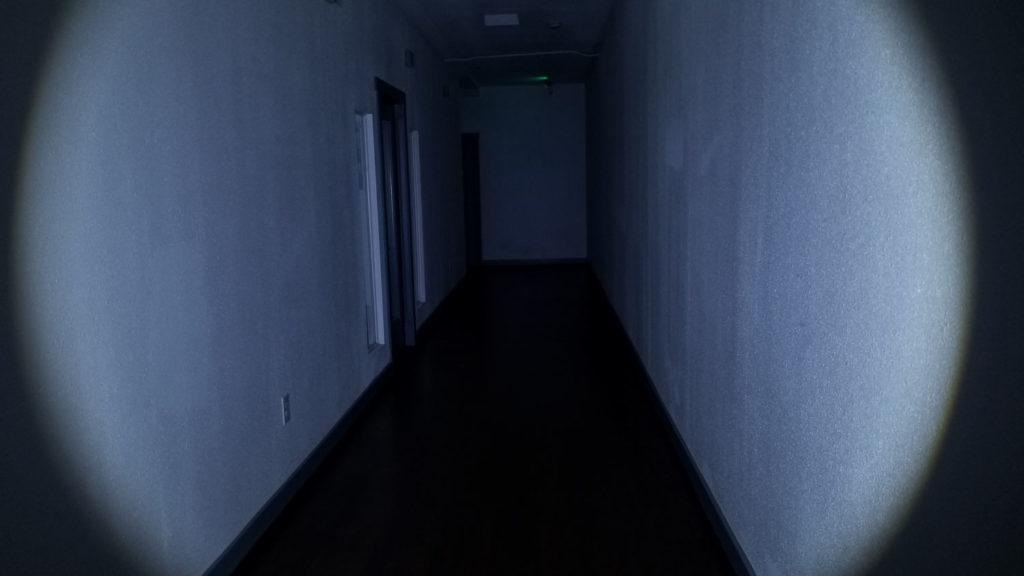
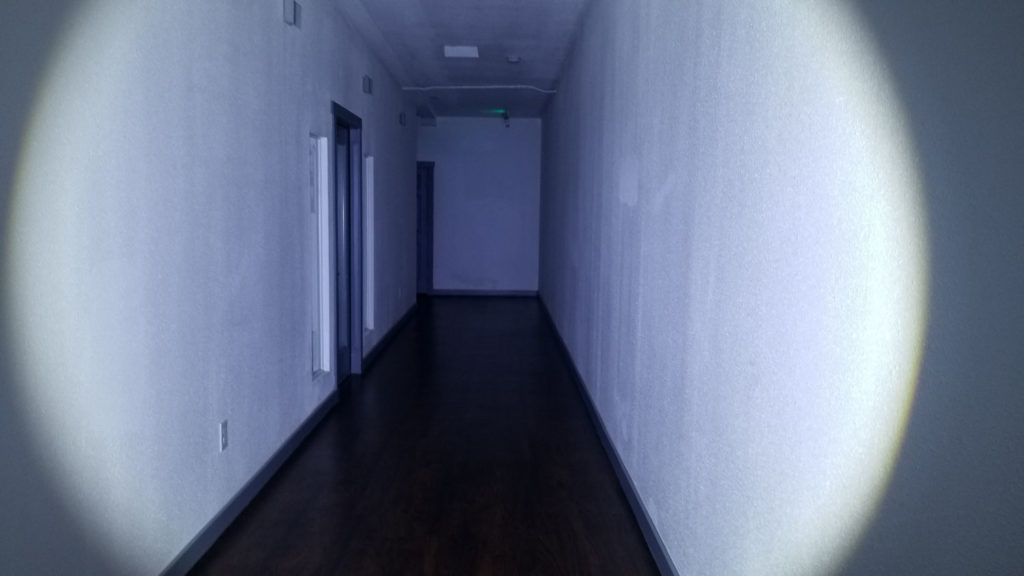
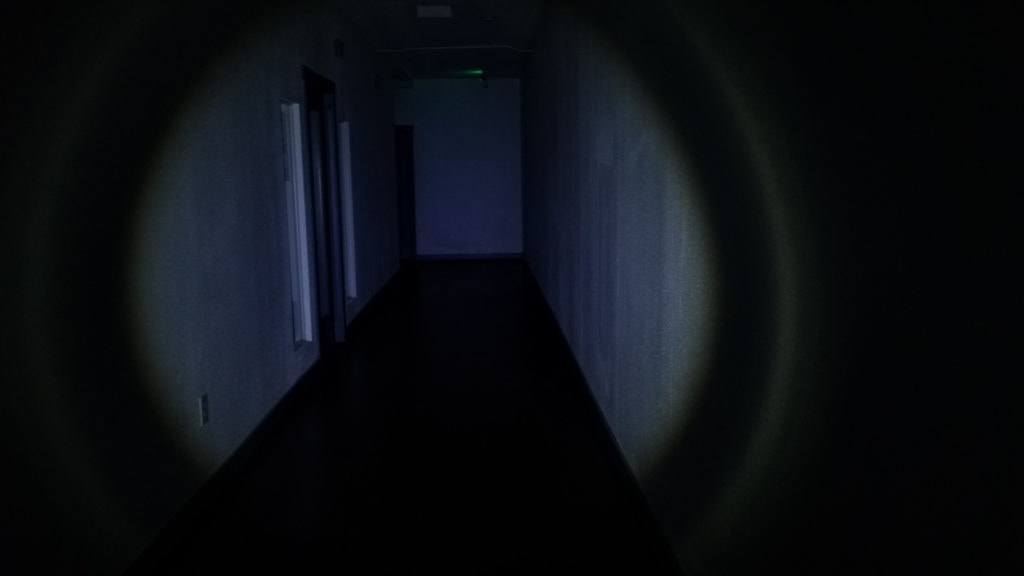
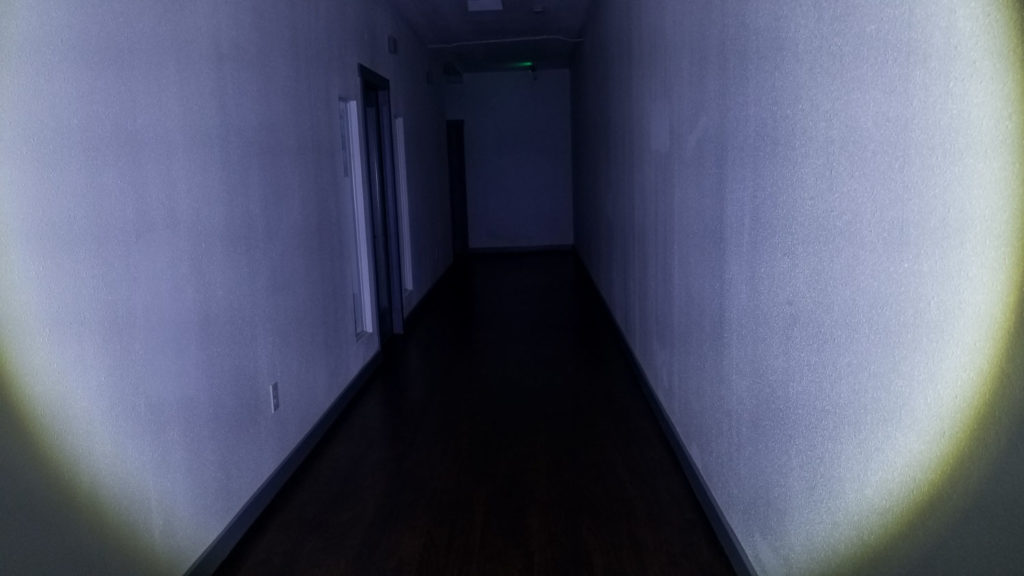
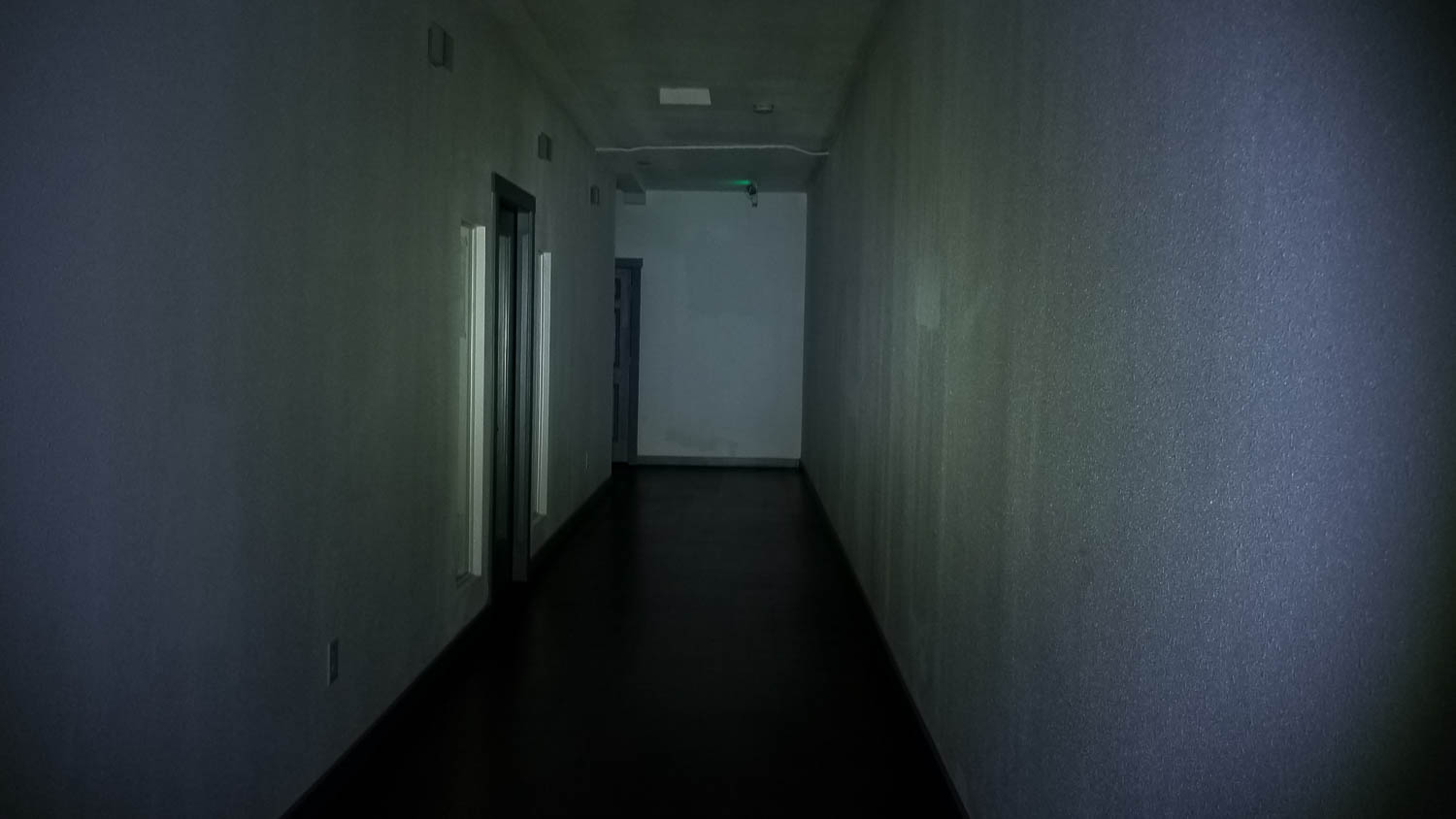
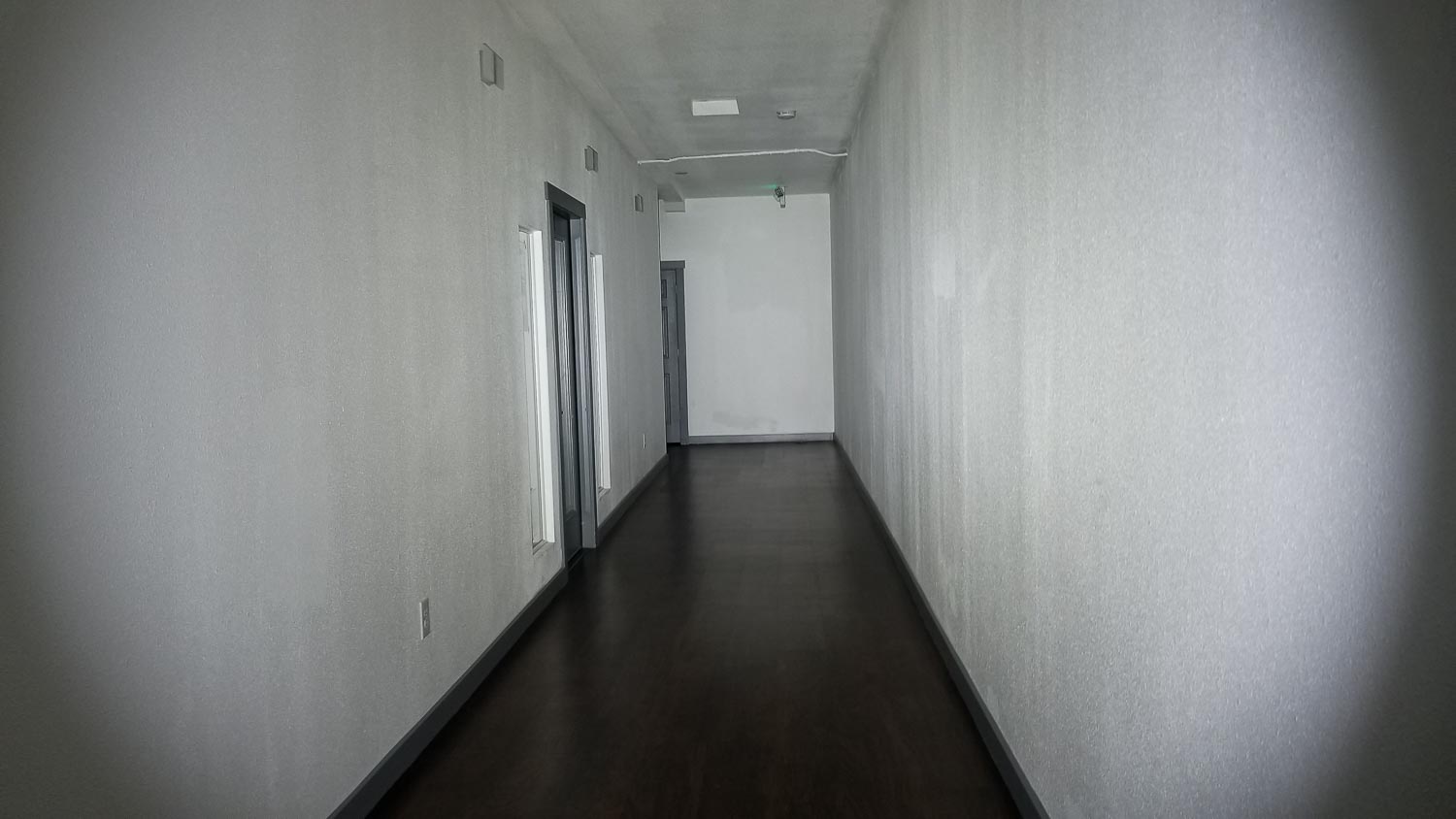
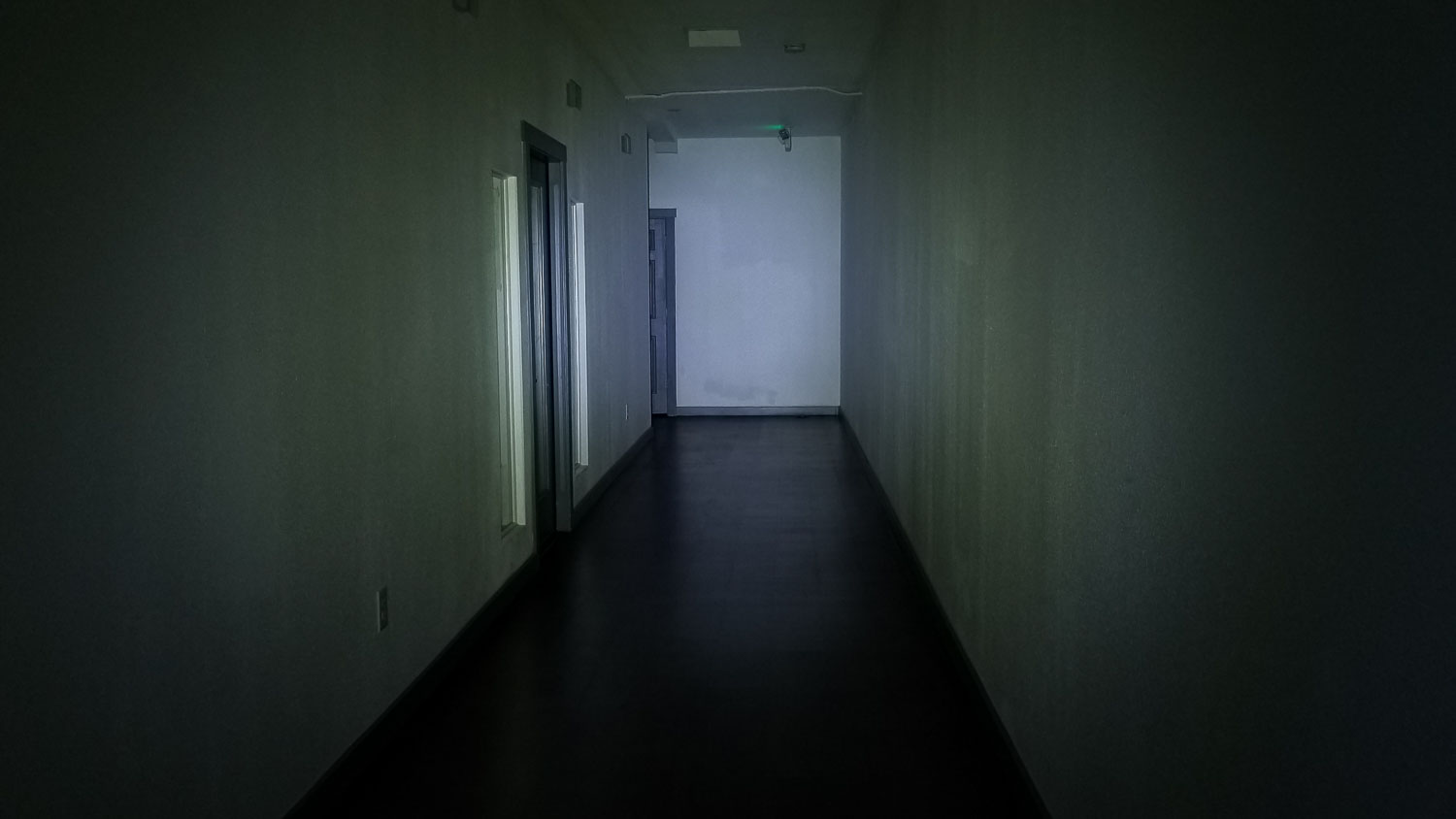
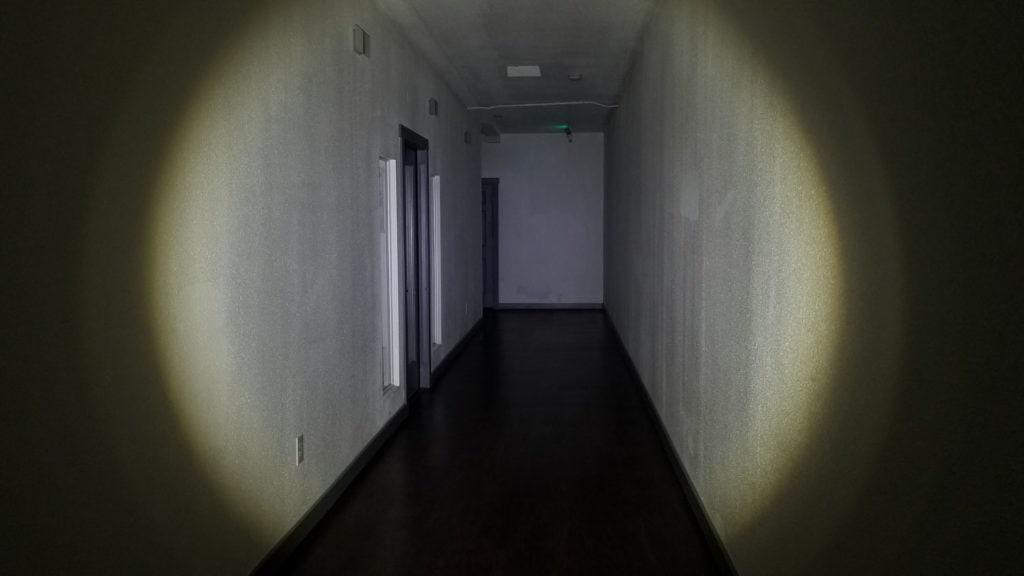
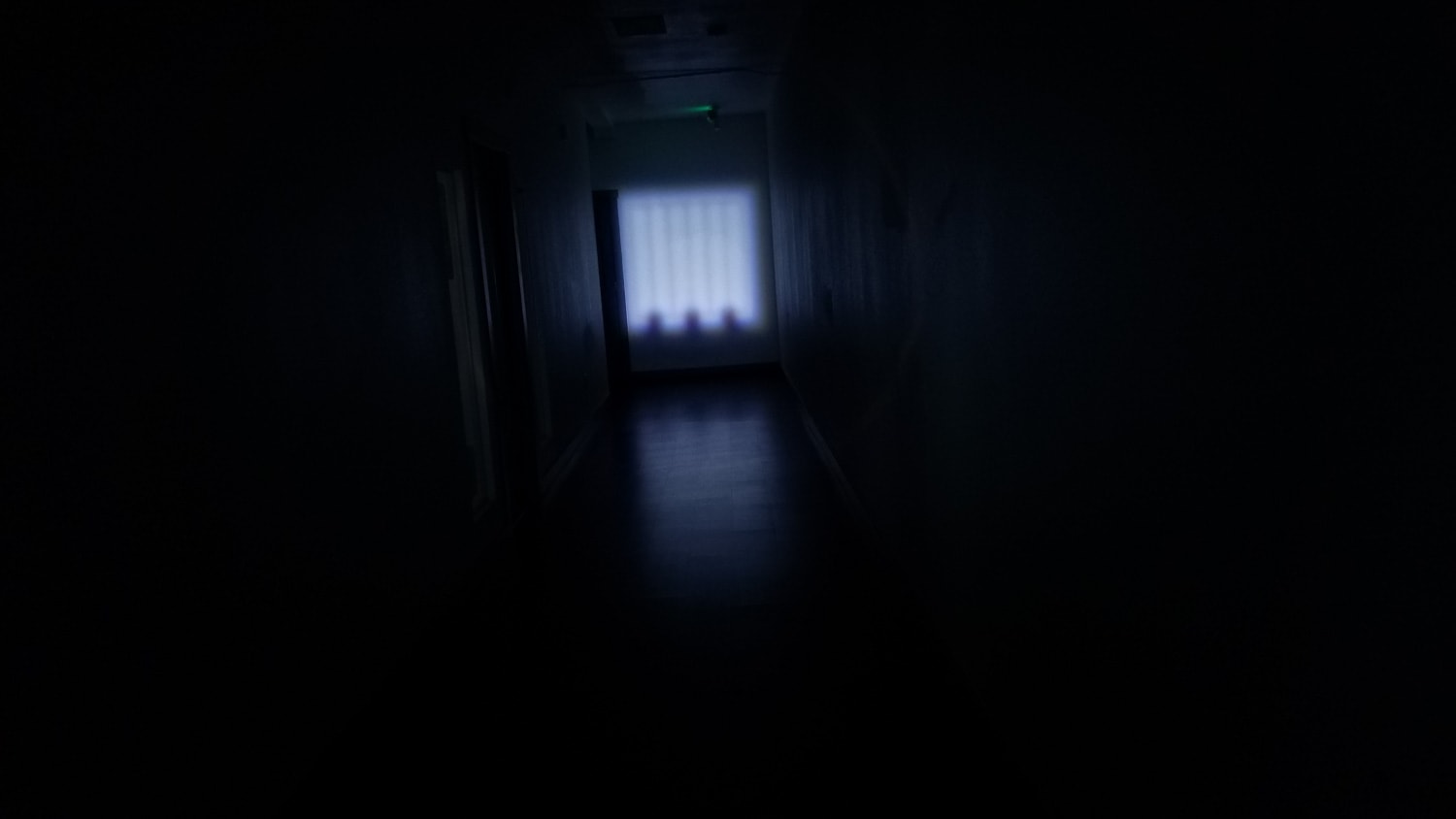
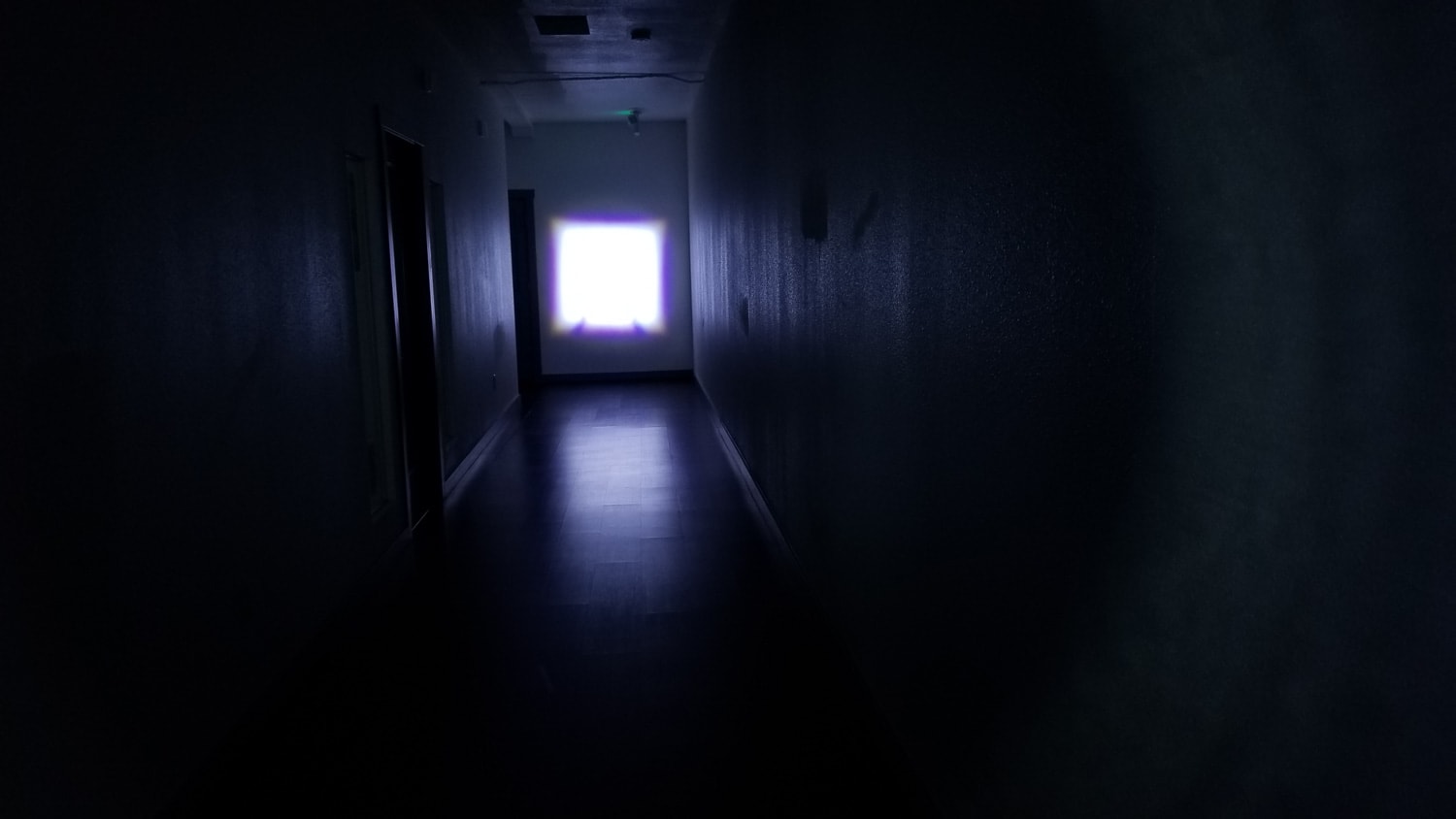
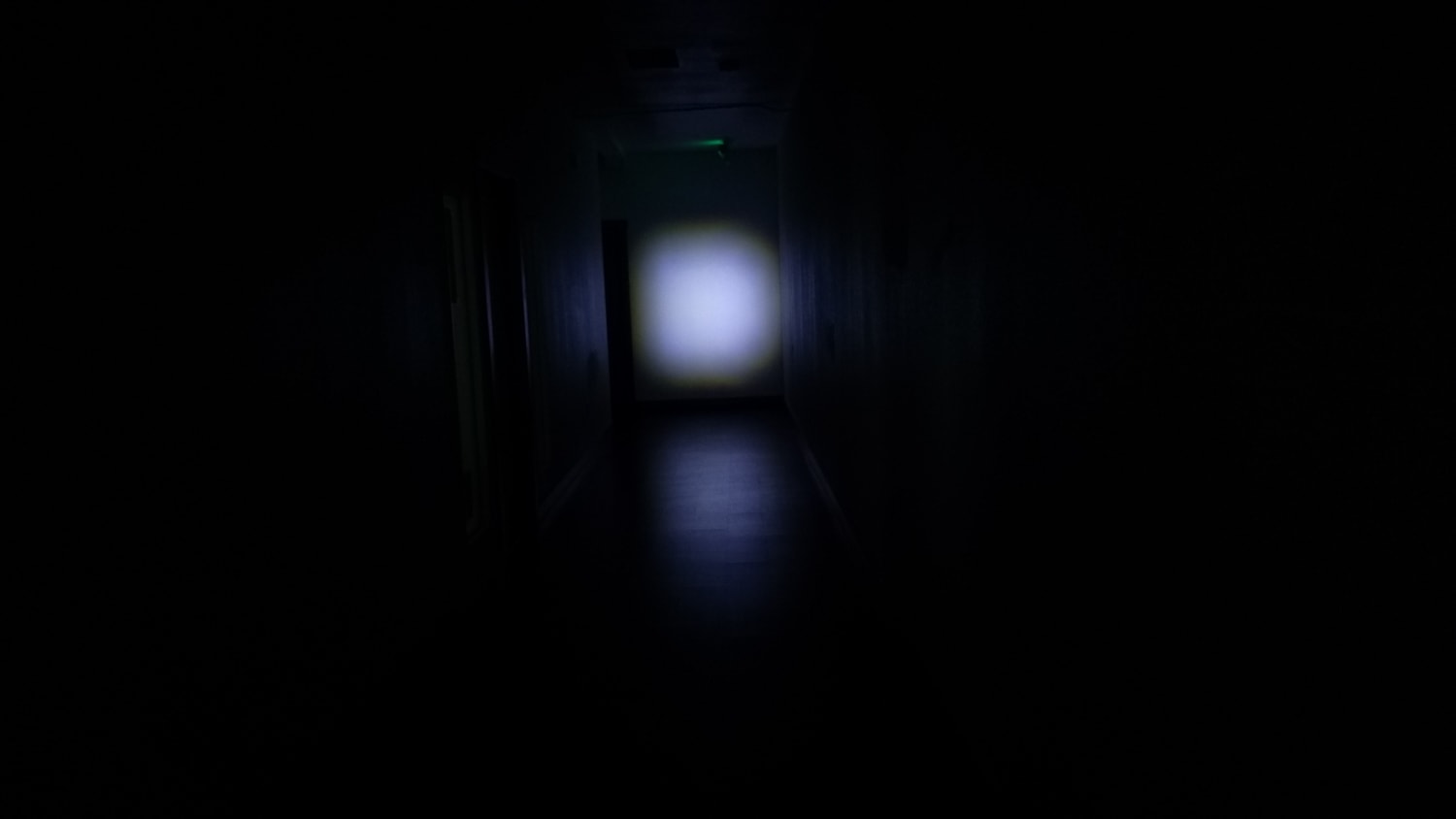
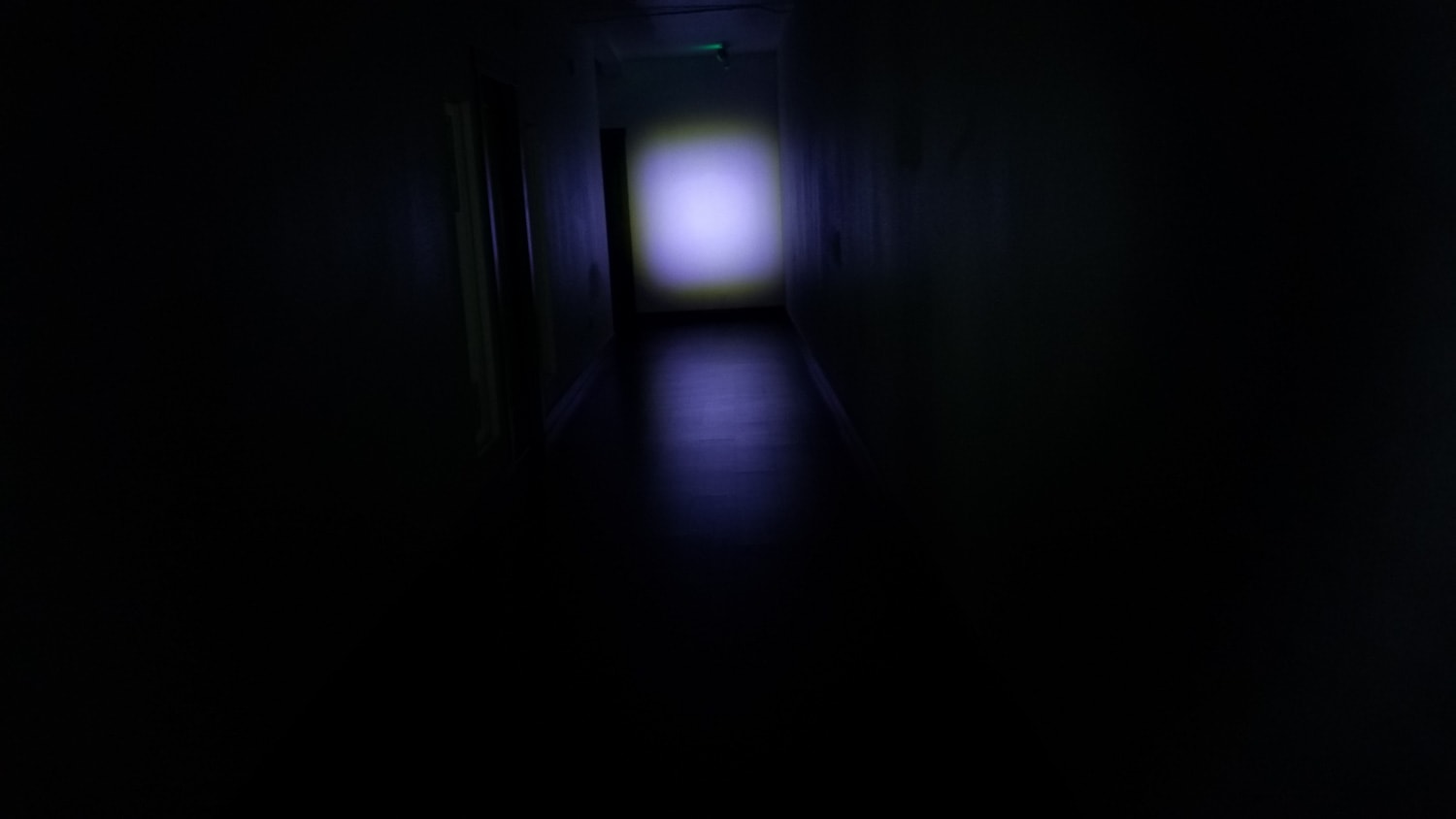
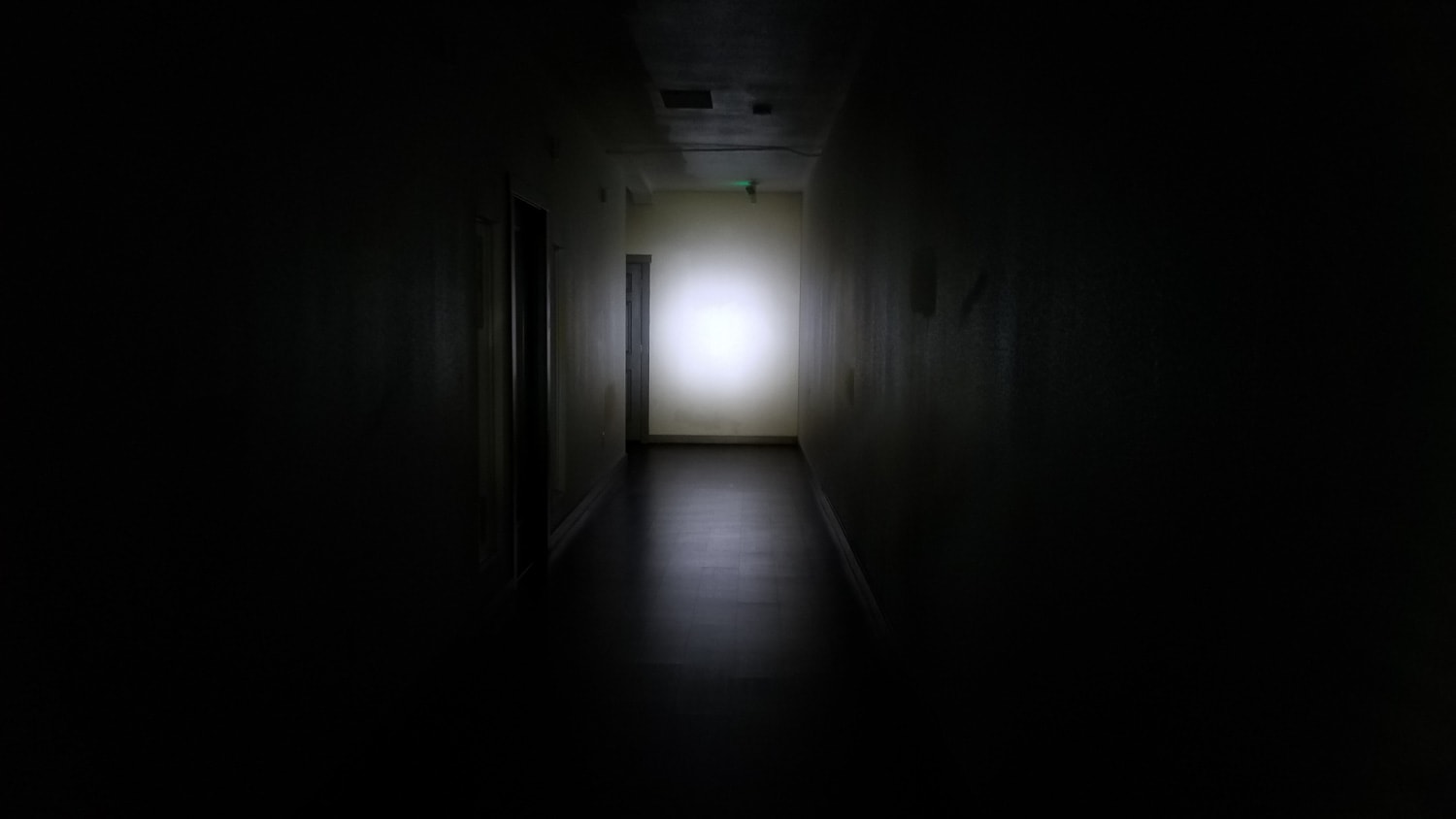
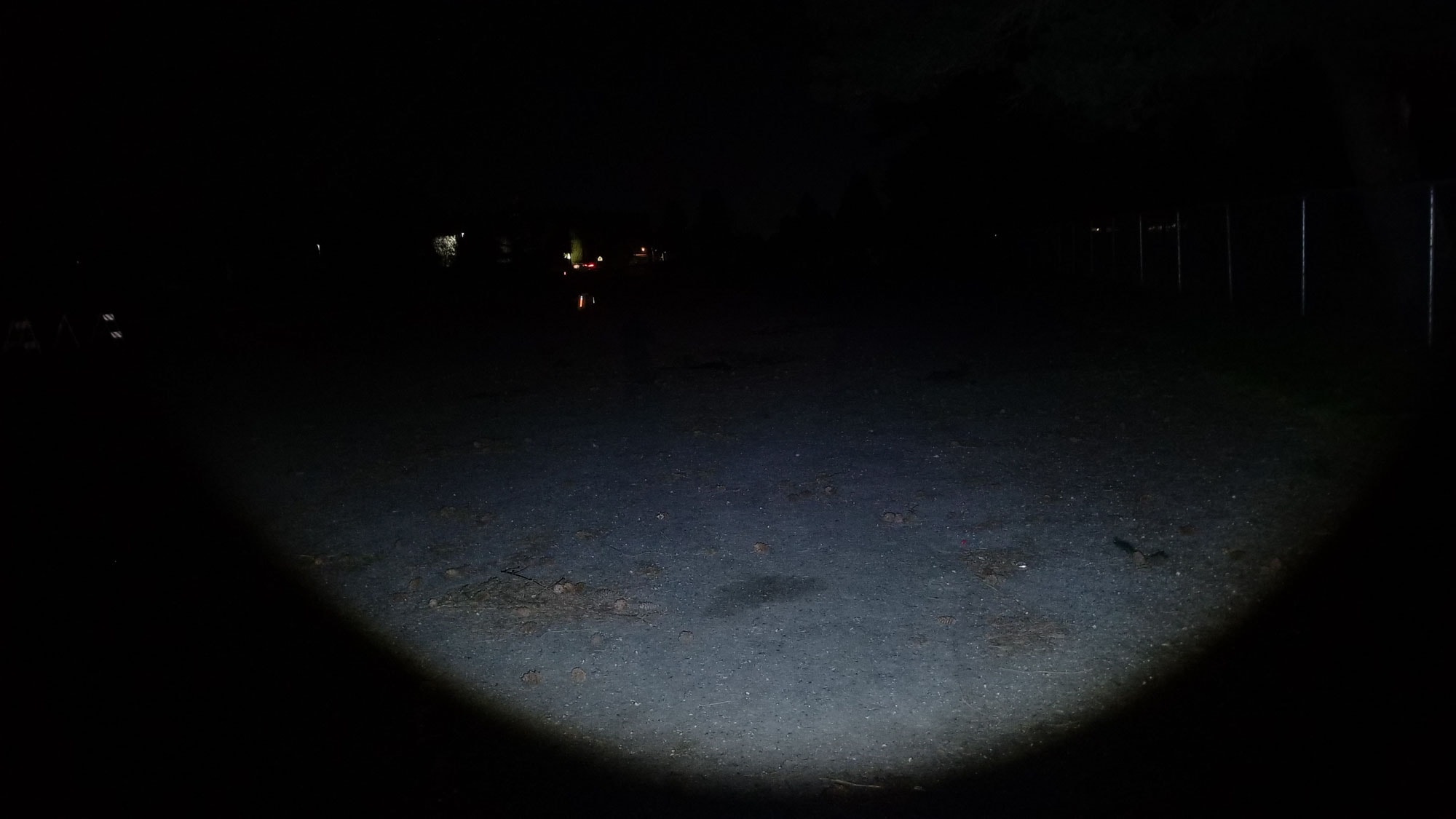

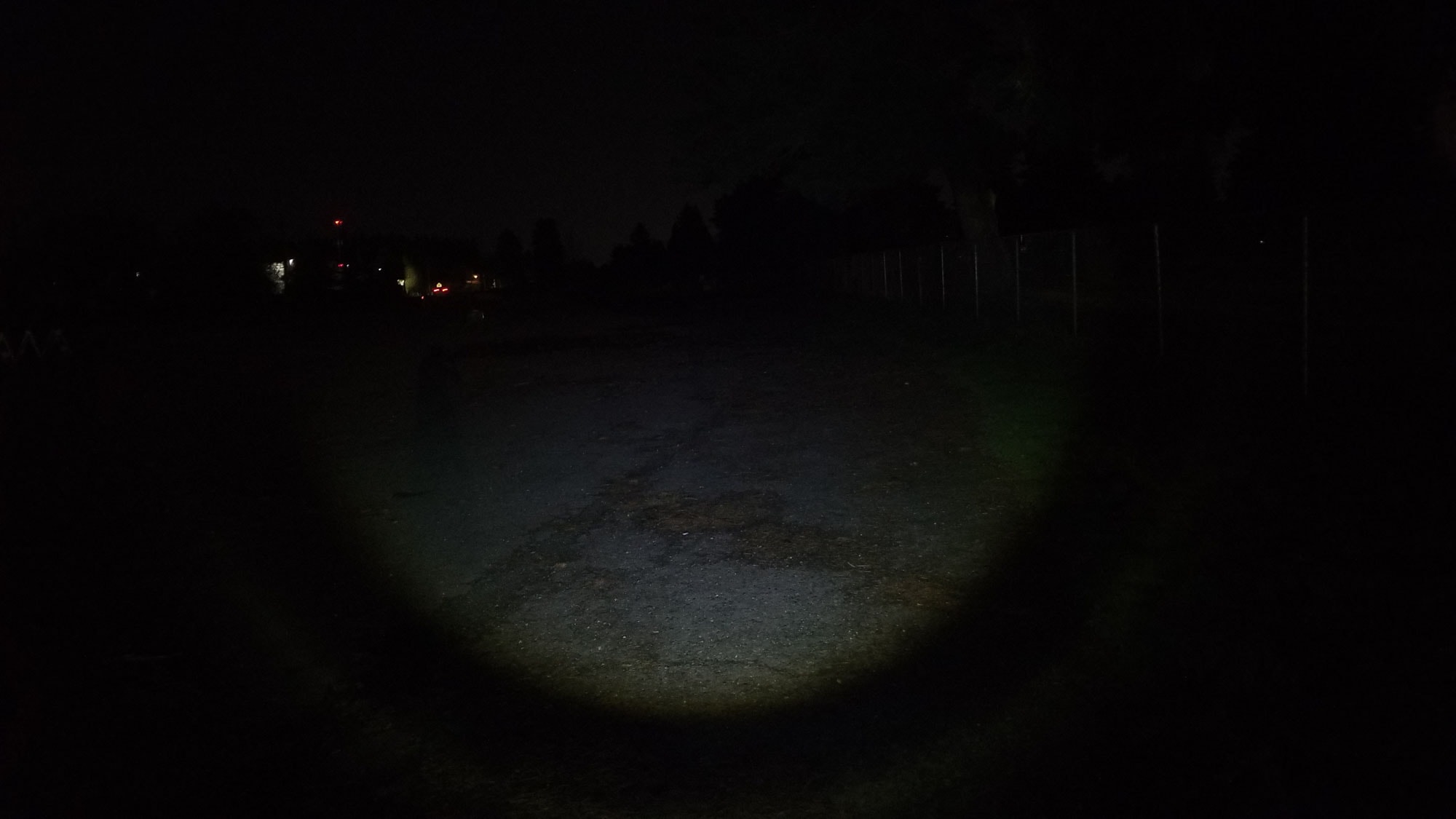
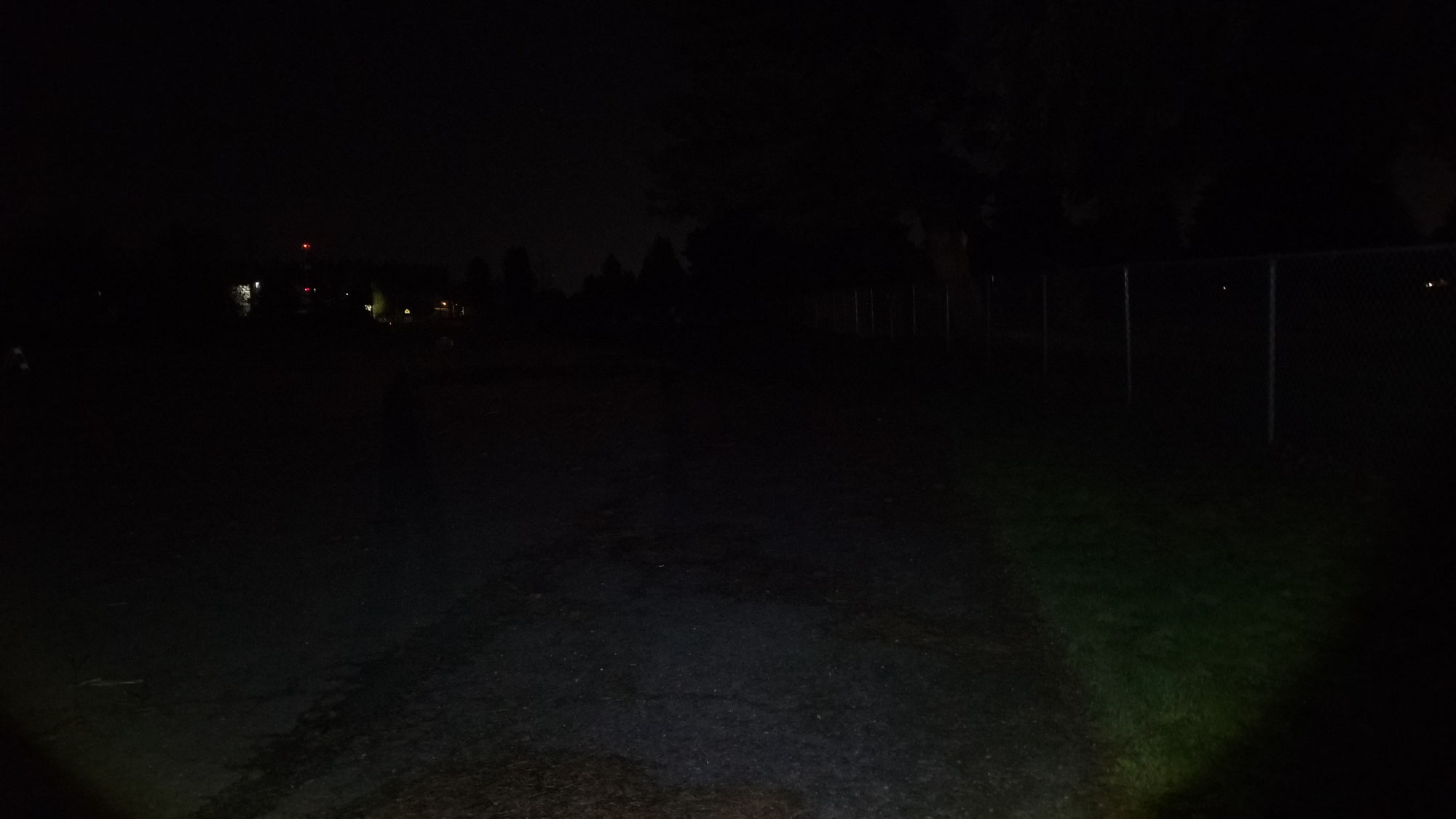

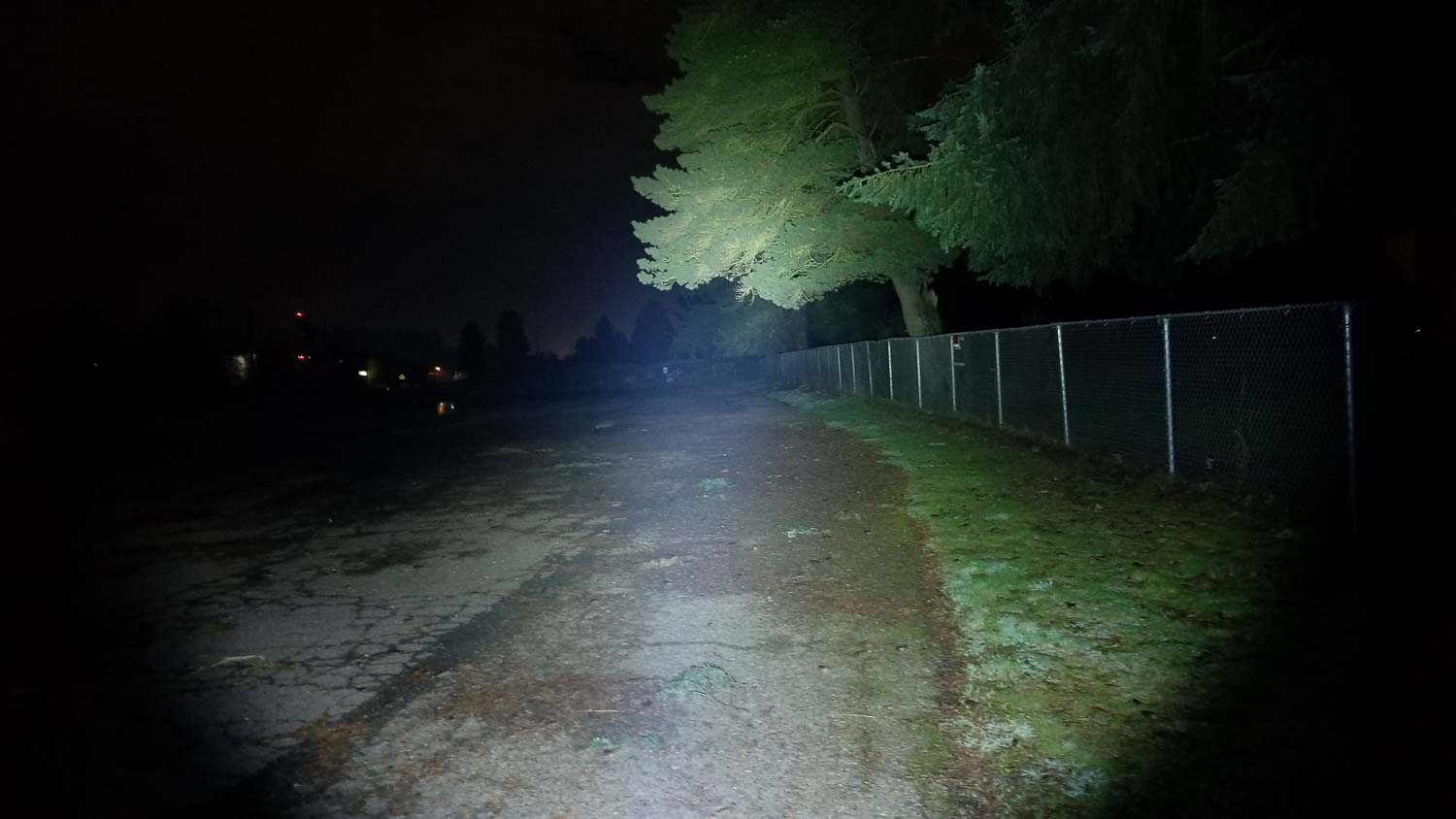
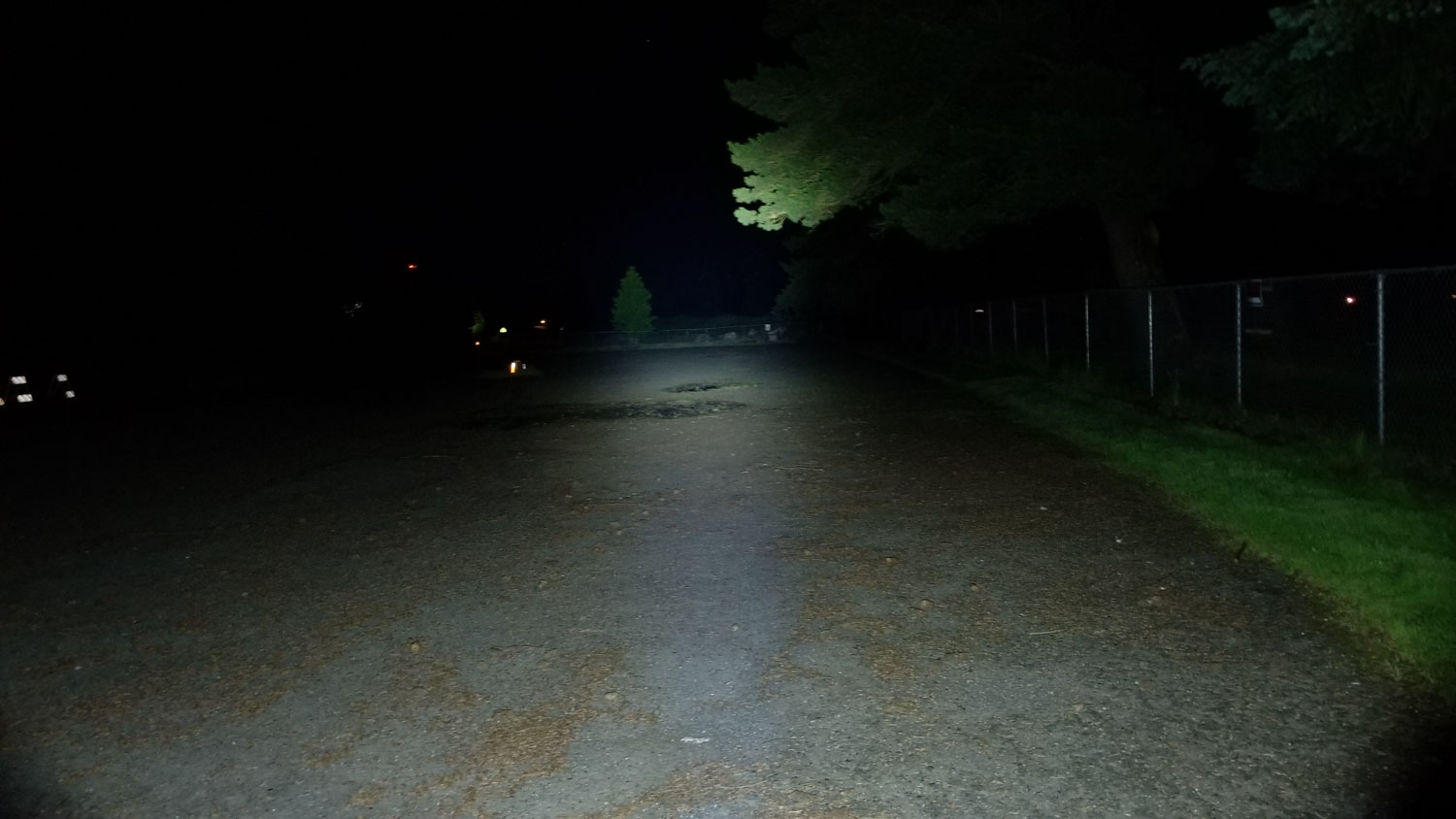
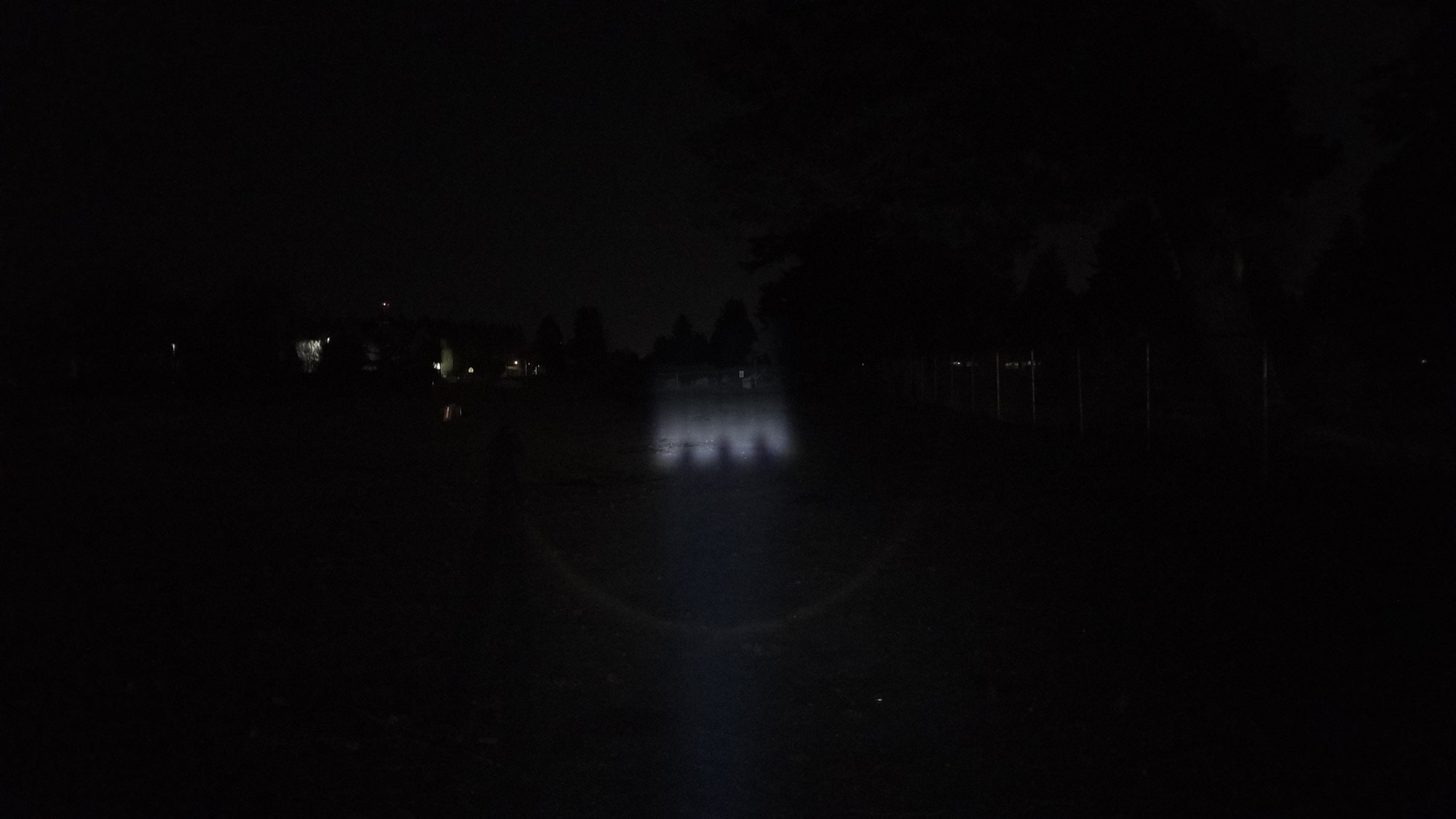
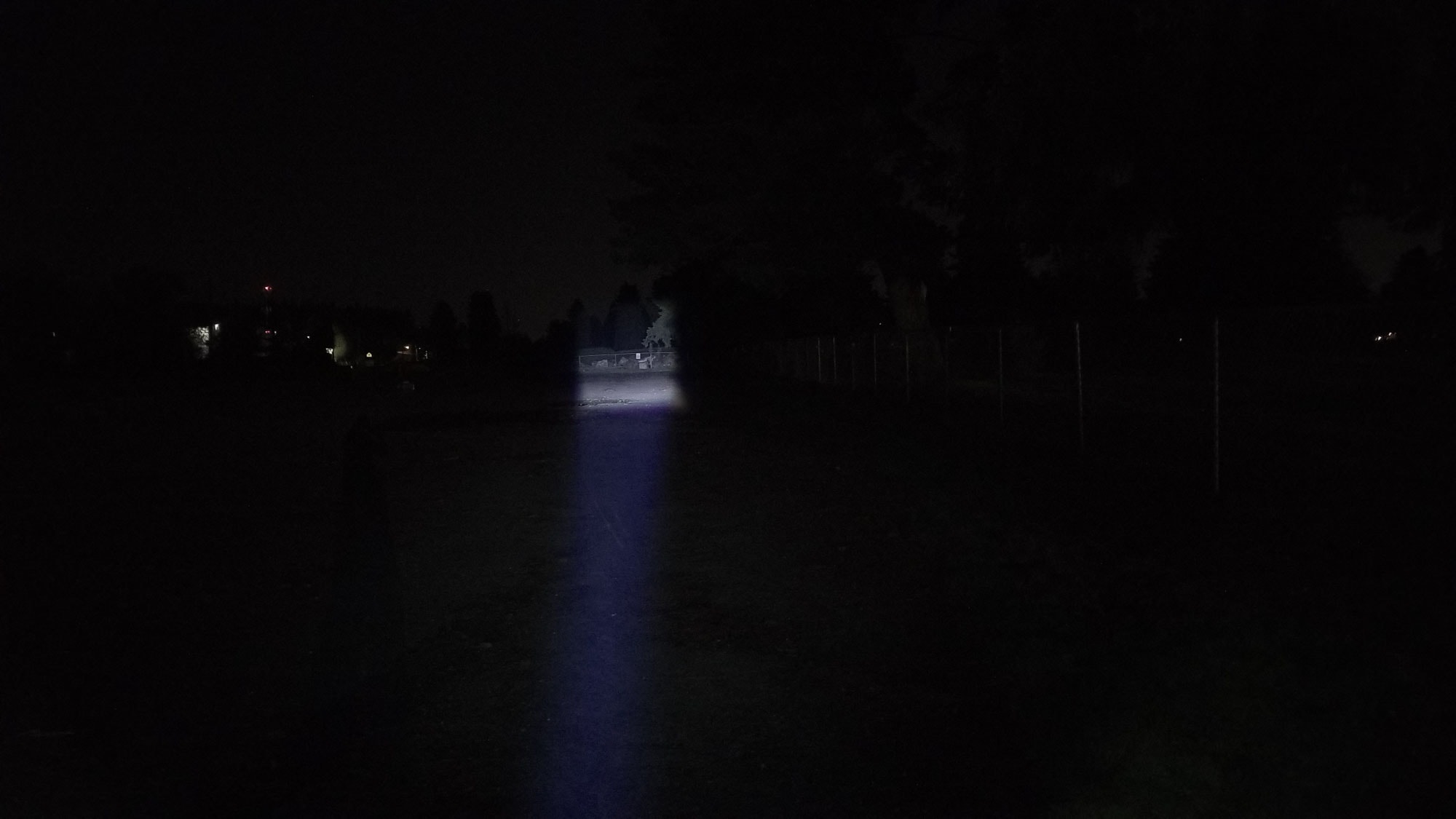
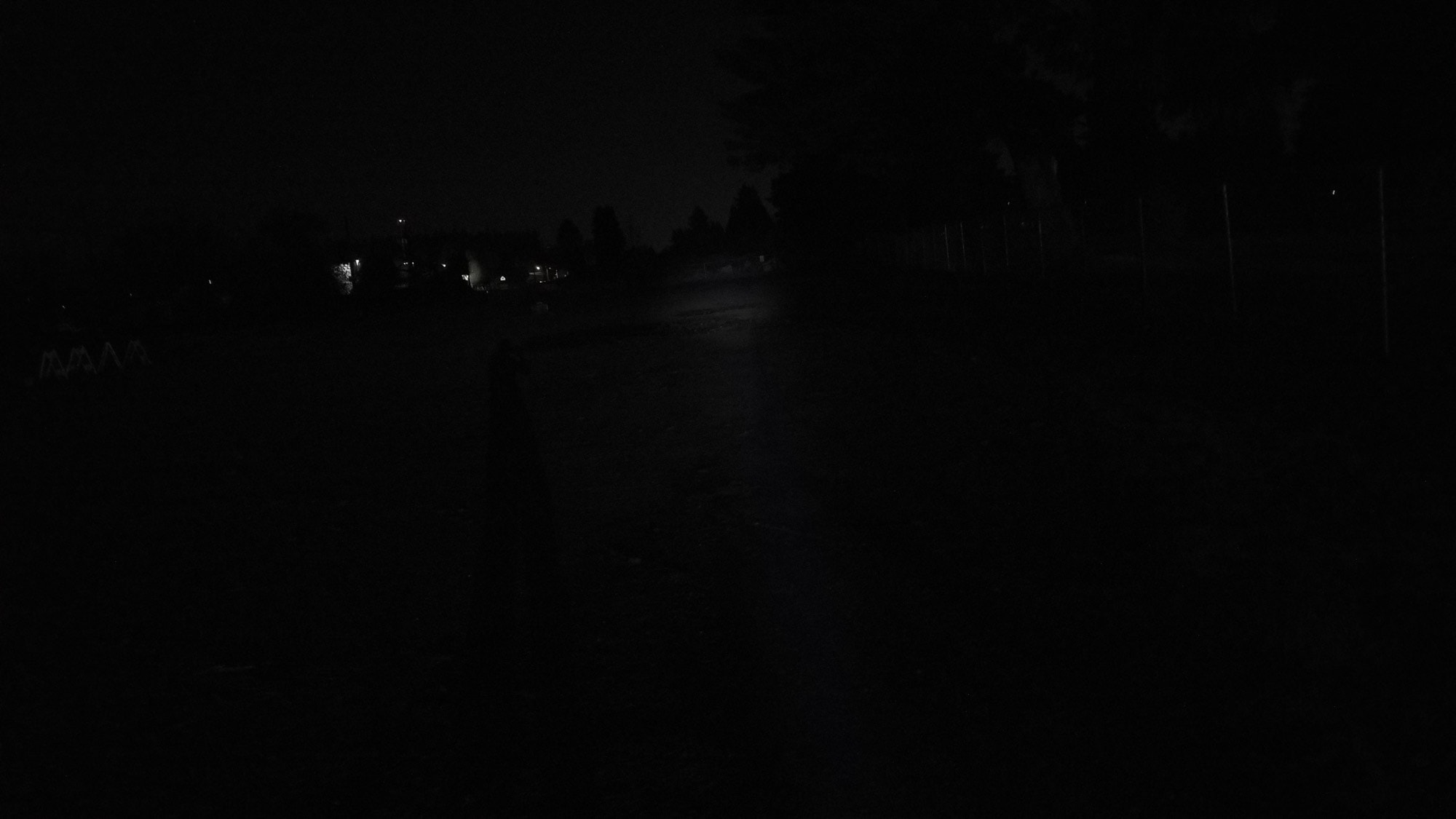
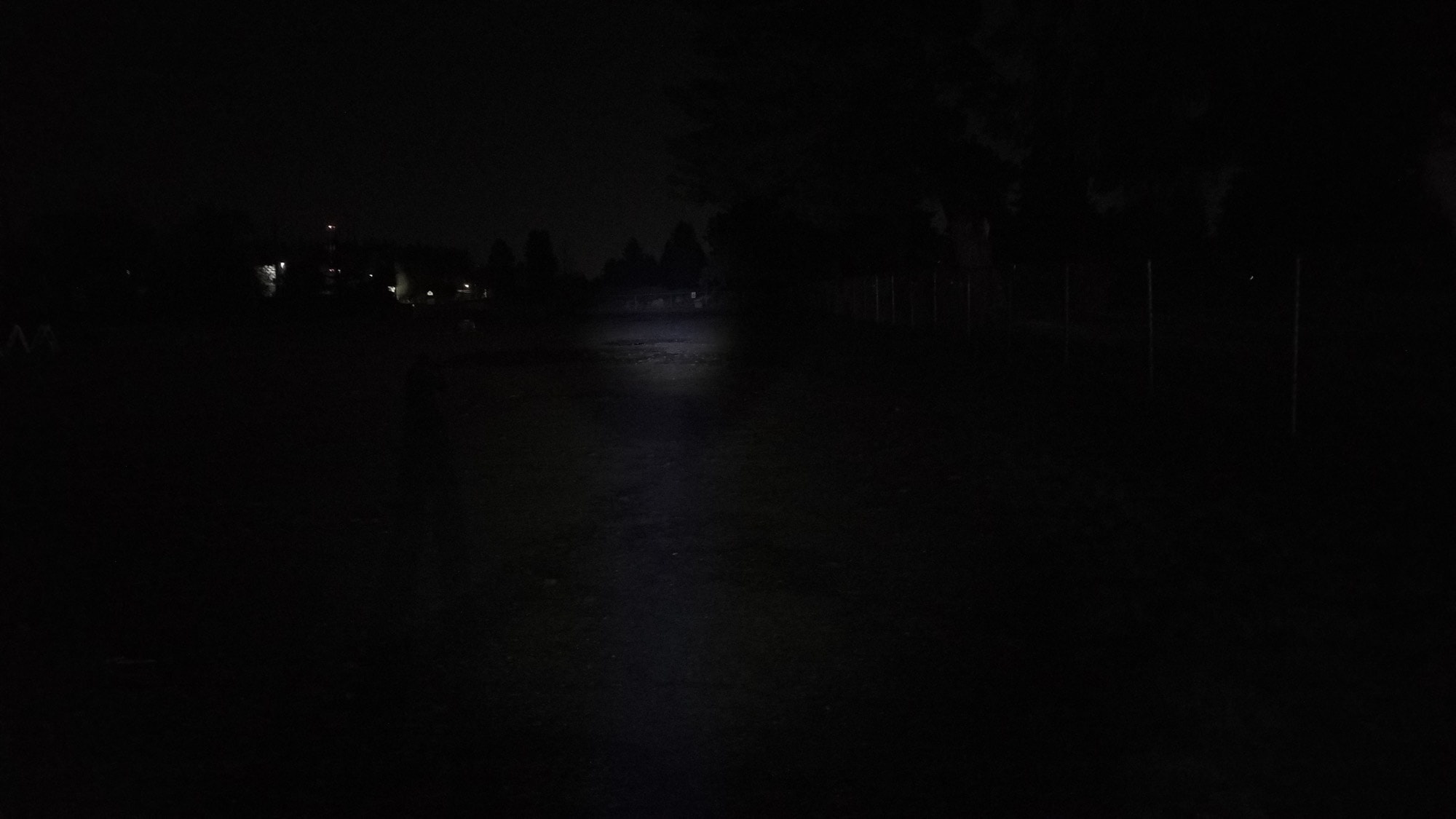
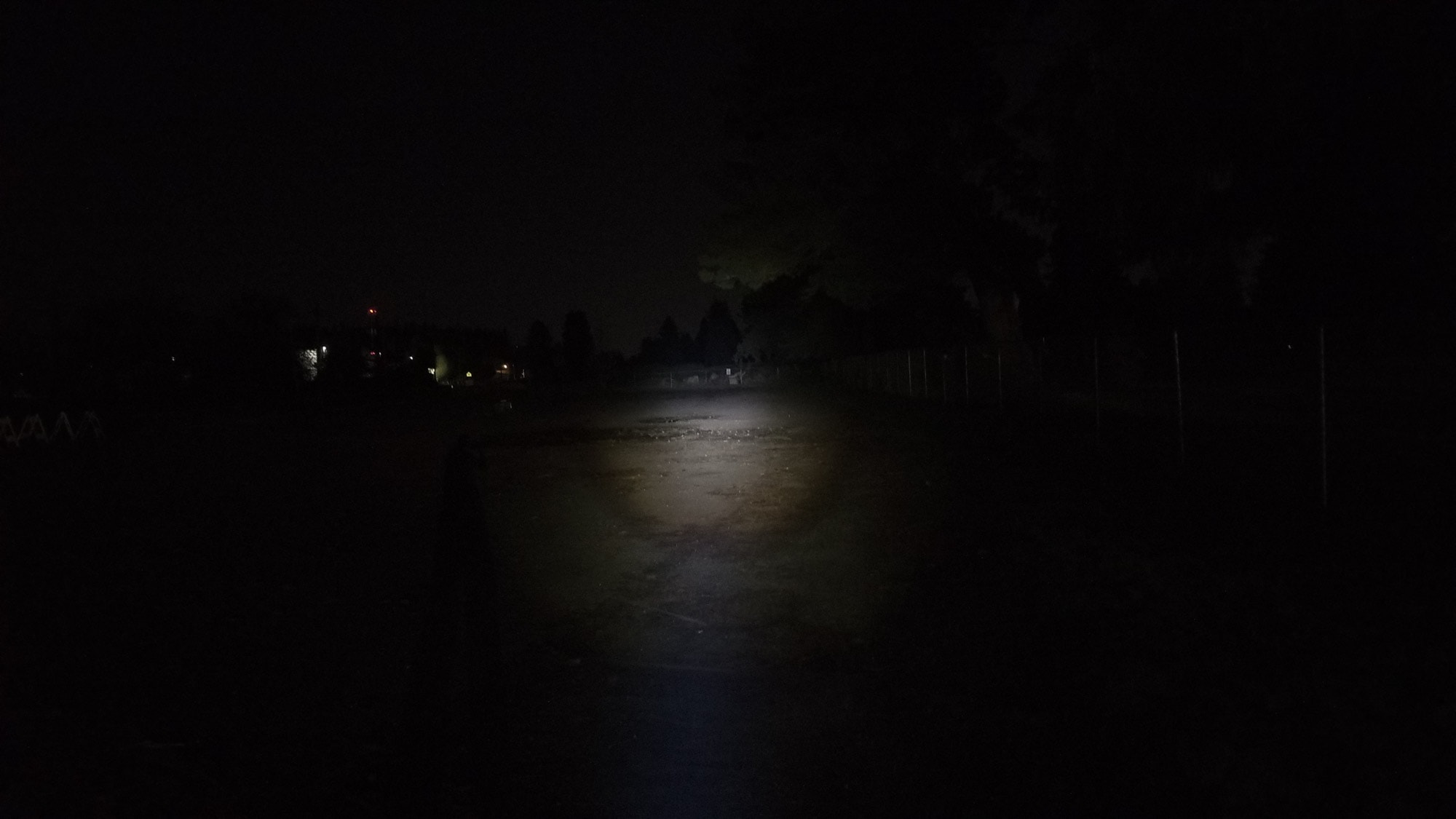
Disclaimer: we bought this flashlight with our own money. Nobody paid me to review this flashlight, nor have I been holding back on problems or defects.
Final Verdict
Pros
- Okay build quality
- Cheap
- Comes in a 2-pack with accessories!
- Decent throw
- Compatible with Alkaline, Nimh, and lithium-ion 18650 batteries
- Did I mention it’s cheap?
Cons
- Bad PWM in Low and Medium modes
- UI is…adequate
- Build quality is just okay
- Cheap, unregulated driver
- Plastic lens
- LED-shaped hotspot
Explanation on star ratings:
1: Avoid: my phone flashlight would be a better choice – 2: Poor: significant defect or issues; almost unusable – 3: Average: some defects or issues; but still usable 4: Good: recommended (minor issues) – 5: Great: highly recommended

2.5 stars: ★★⋆
Occasionally a flashlight reviewer has to face the fact that not all flashlights that come across their desk are the latest and greatest. With the Gearlight S1000, I set out to answer the questions on everybody’s mind and address a few key points: Just how much flashlight do you get for roughly $11, and is a cheap flashlight really any good? The most-popular-flashlight-on-Amazon Gearlight S1000 does what a flashlight does best: Put light where there isn’t any. It will help you find your missing keys, the Cheeto you dropped under the couch, or keep you from trodding on Legos at night. It’s also useful for scaring away raccoons or the neighbor’s dog rummaging through your bins at night.
The Amazon listing says this is a “tactical” flashlight, but of course it isn’t. It won’t win any runtime, output, beam, or build quality contests, and with the cheap, basic diver there’s no mode memory. It always starts on High, and the blinkies are part of the regular modes. Alas, I digress because the million-dollar question remains: Is the S1000 a bad flashlight? Well, the UI, while barely adequate, is simple, it takes an 18650 battery (with LVP). It didn’t catch fire or fall apart, and I didn’t experience any major build quality issues. Lastly, it turned on every time I asked it to, so if I were adjudicating it solely on those facts, I’d give it 5 stars and call it a day. However, the fact remains that there are too many better choices out there like the Sofirn SP10 V3 or SC31T, Lumintop Tool AA 2.0, Skilhunt E2A, etc. Those will give you great performance, good quality beams, decent runtimes, and quality LEDs while being just as easy to use. Now, you might not care about all that, and want a light you won’t fret over if it gets dropped down a black hole, eaten by a T-Rex, or stolen by Hobbits (plus you’ve got a spare). That said, I’m still giving it 2.5 stars because there are better options out there for about the same price. Amazon’s great, but for thorough reviews and buying guides for flashlights, check out 1Lumen’s guides.
Gearlight S1000 For Sale
Still interested? You can get it at Amazon, or just check out their fun reviews, lol
1lumen selects and reviews products personally. We may earn affiliate commissions through our links, which help support our testing.